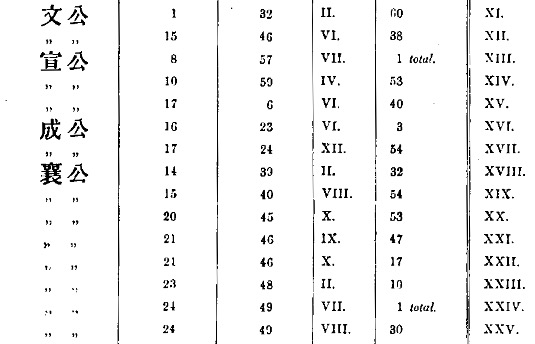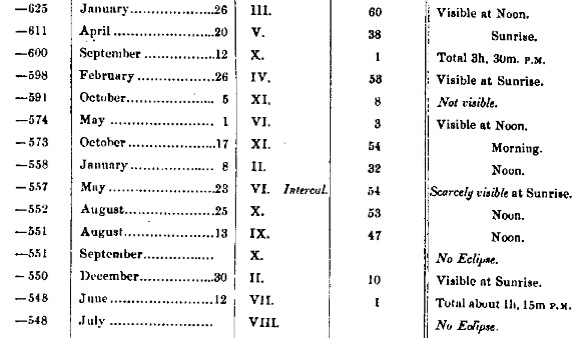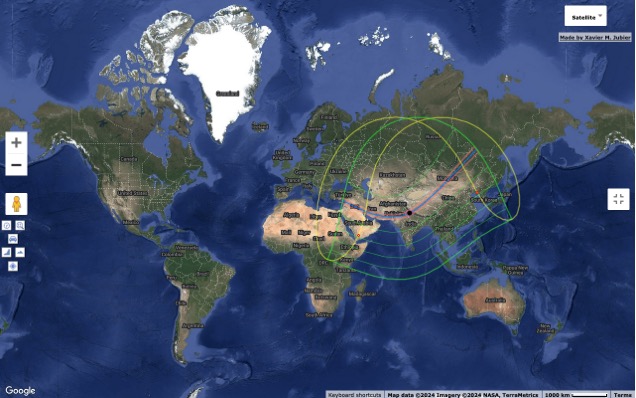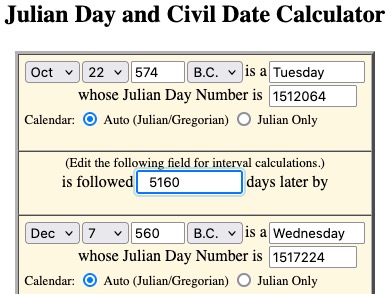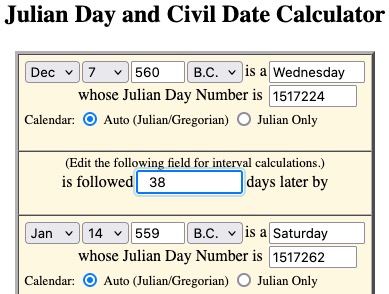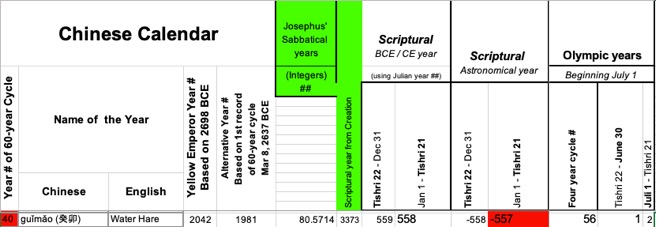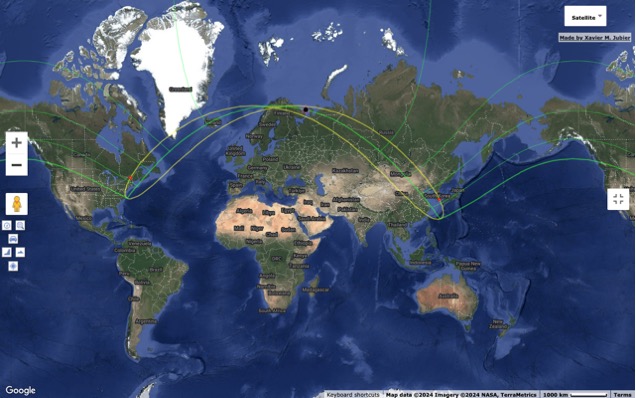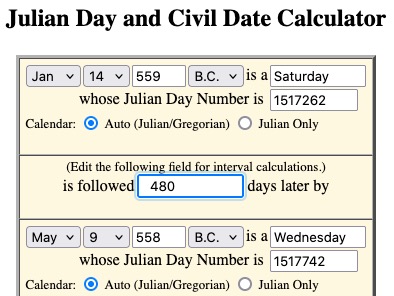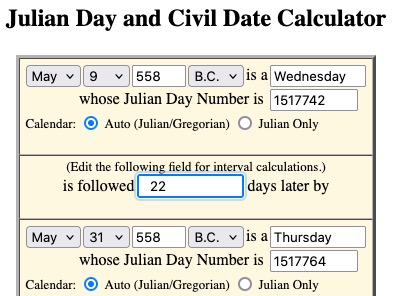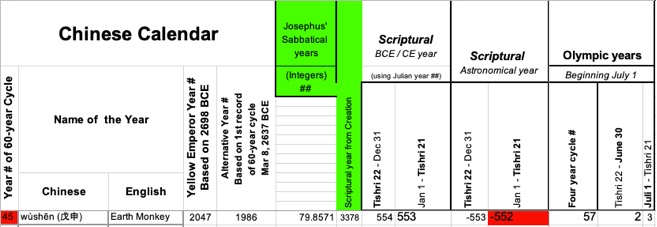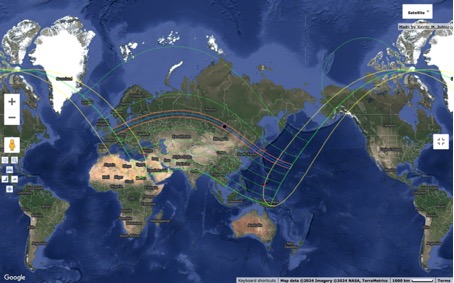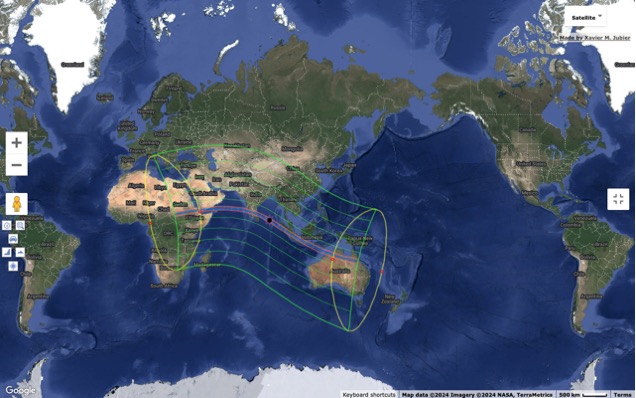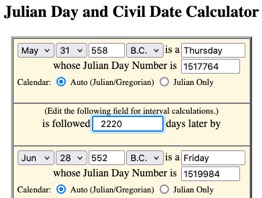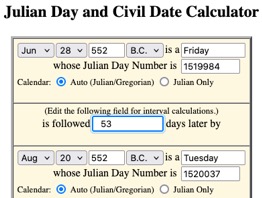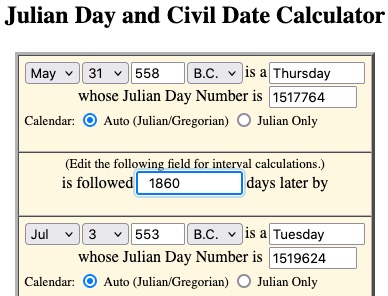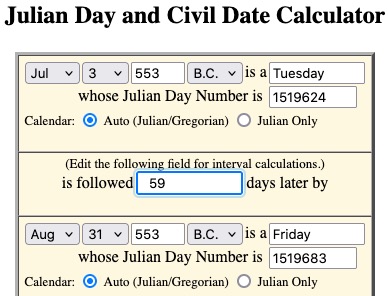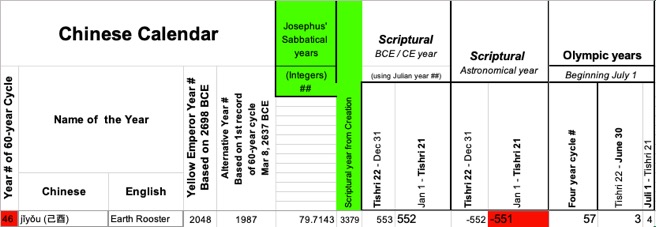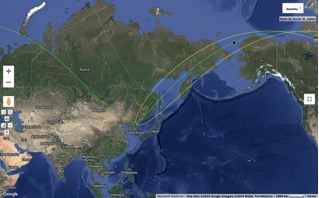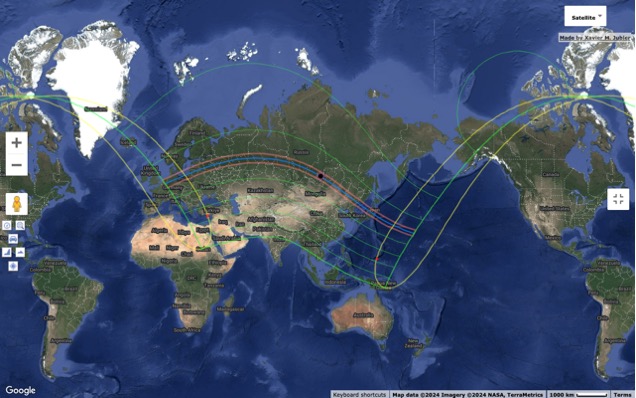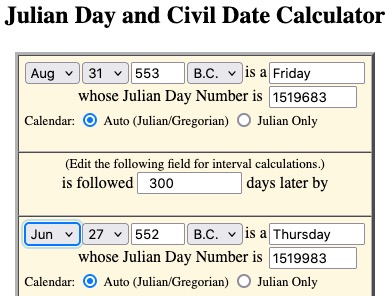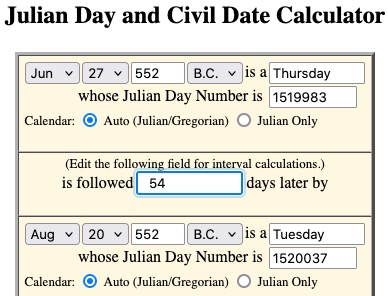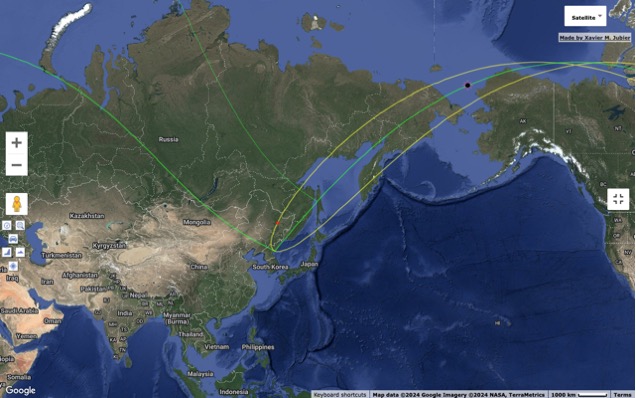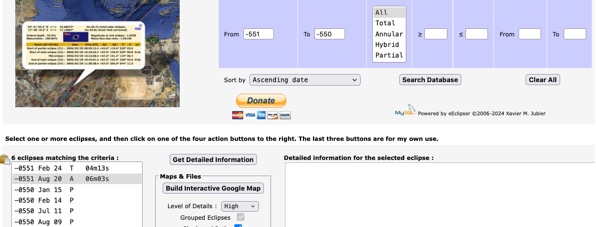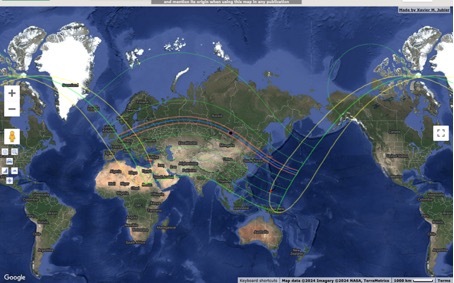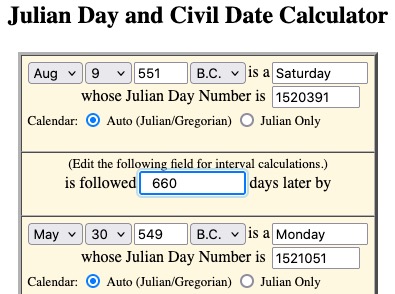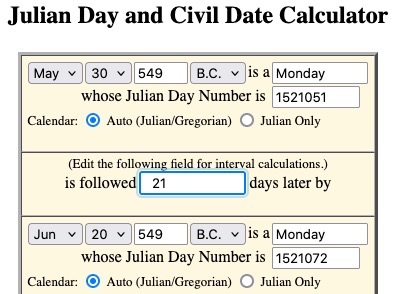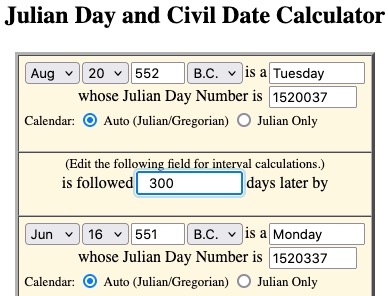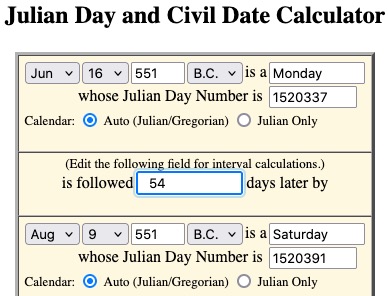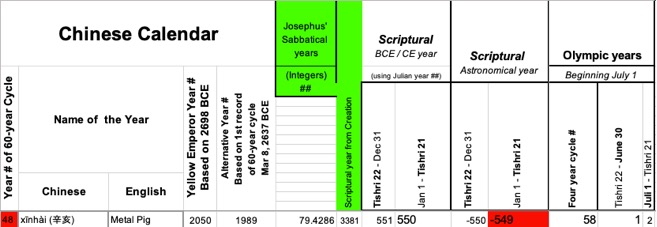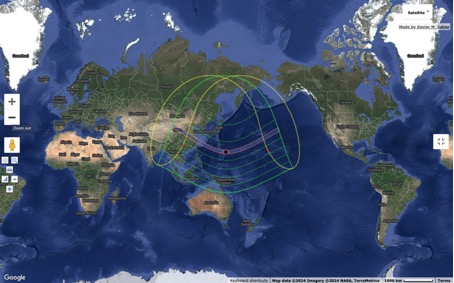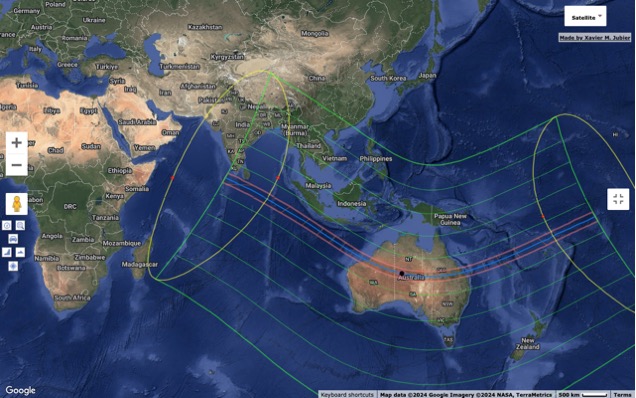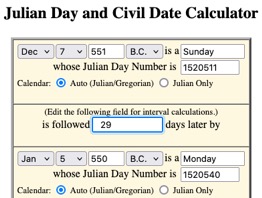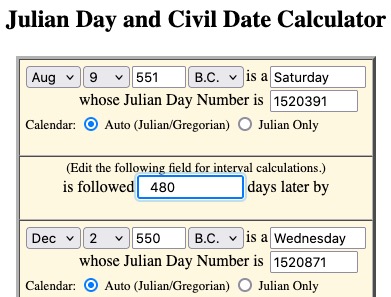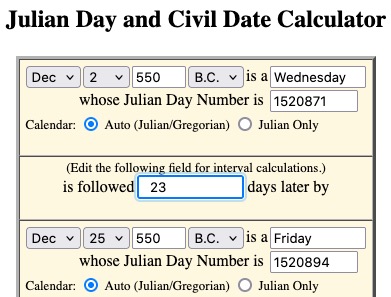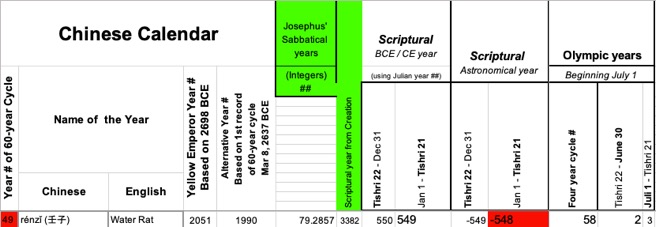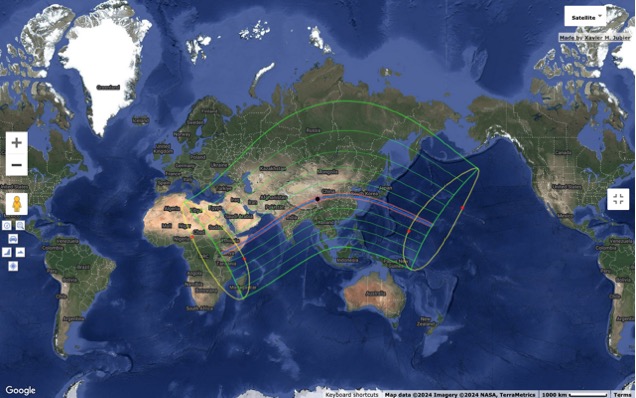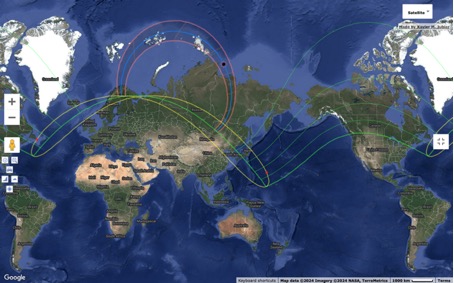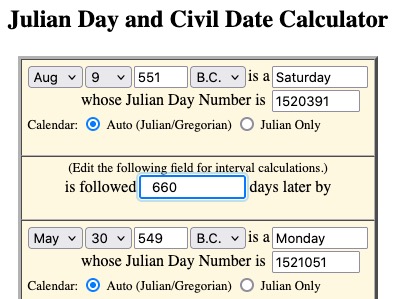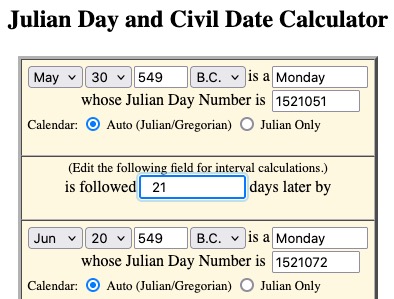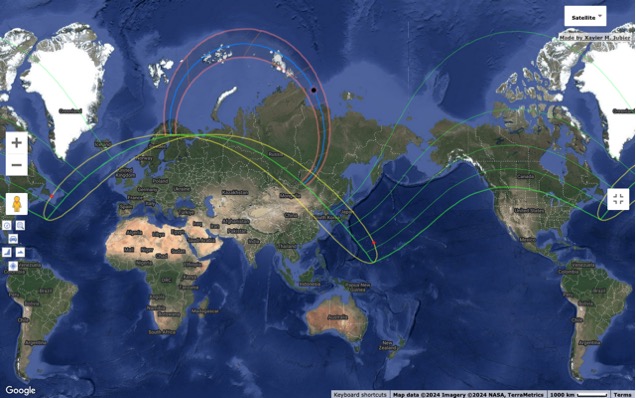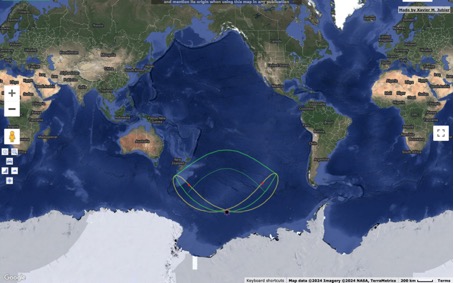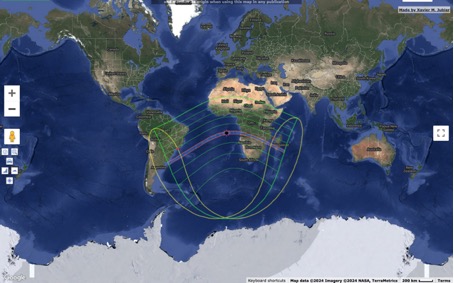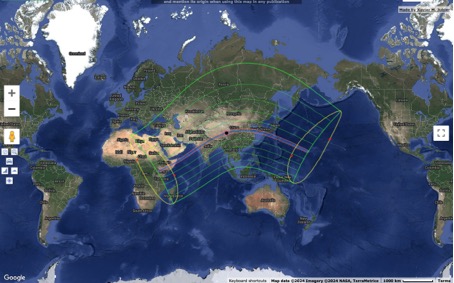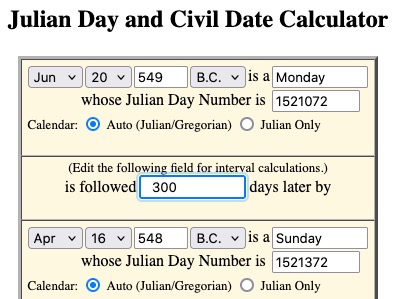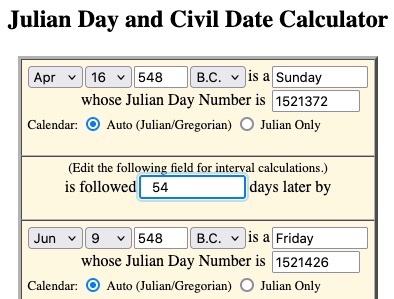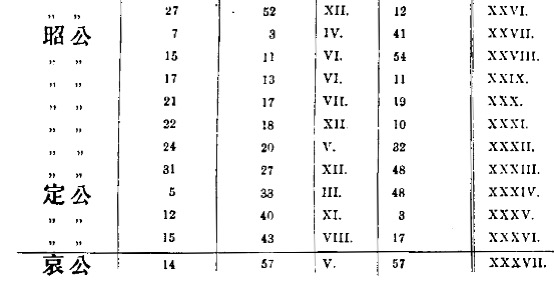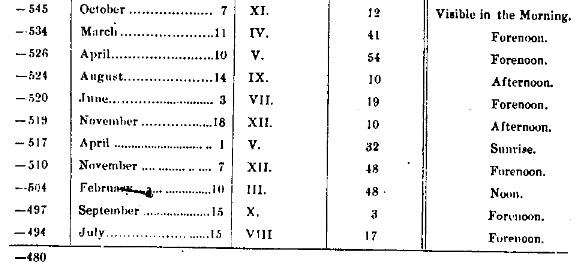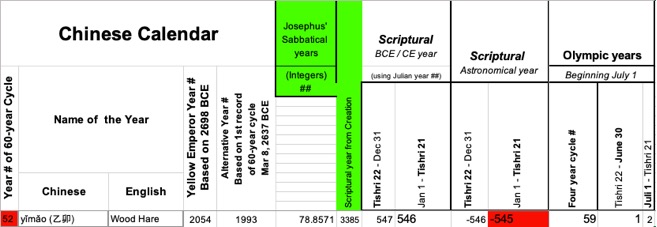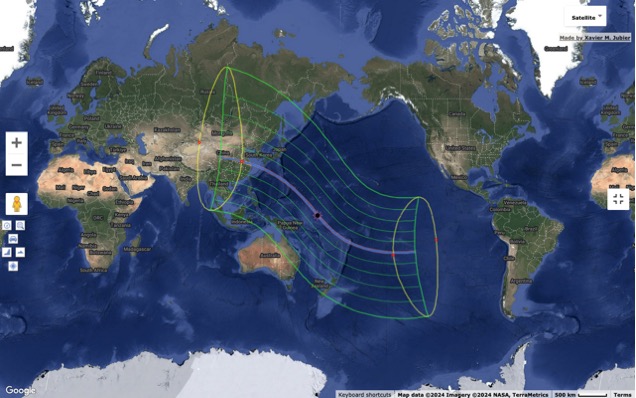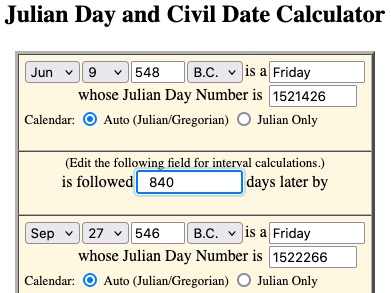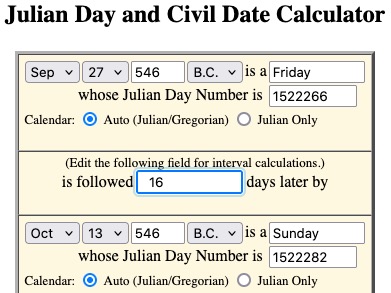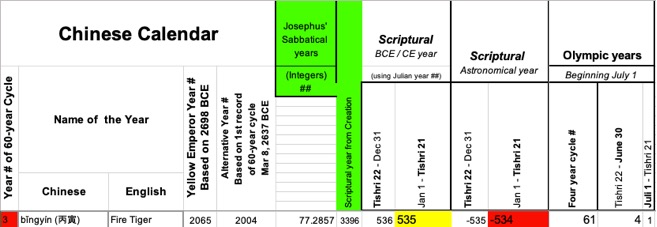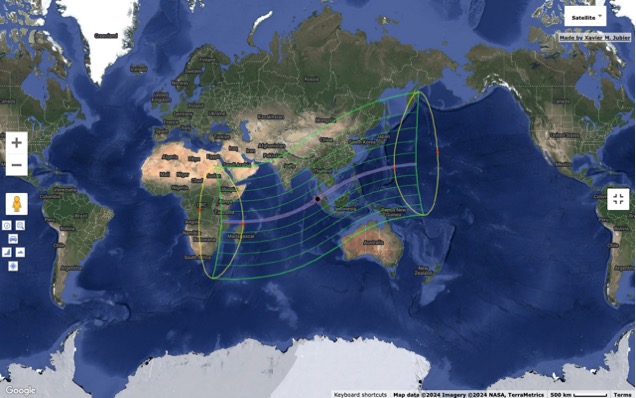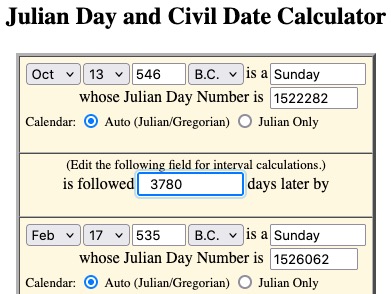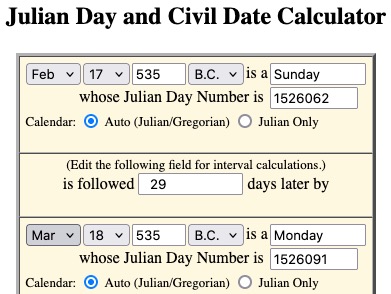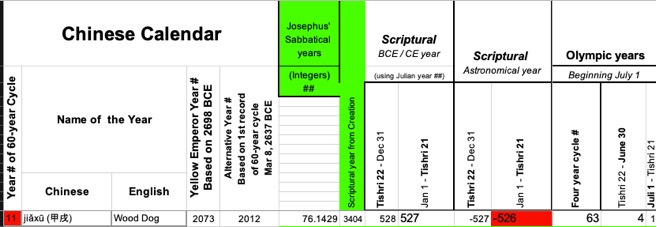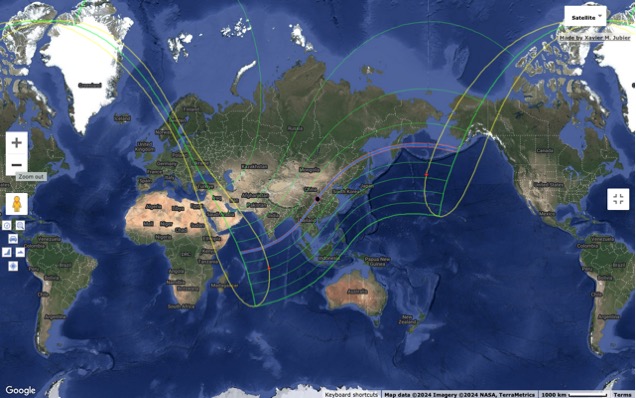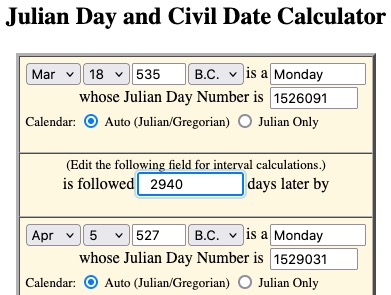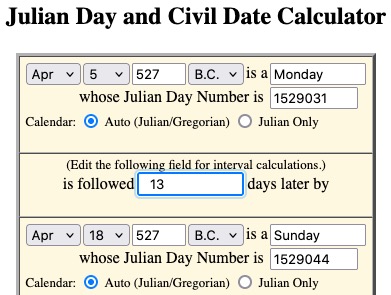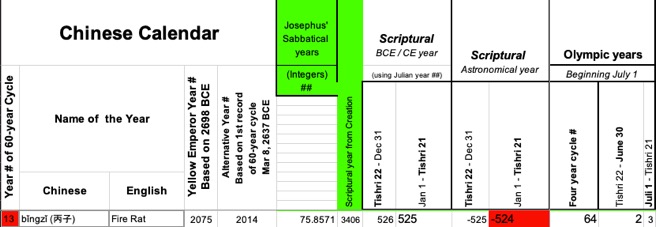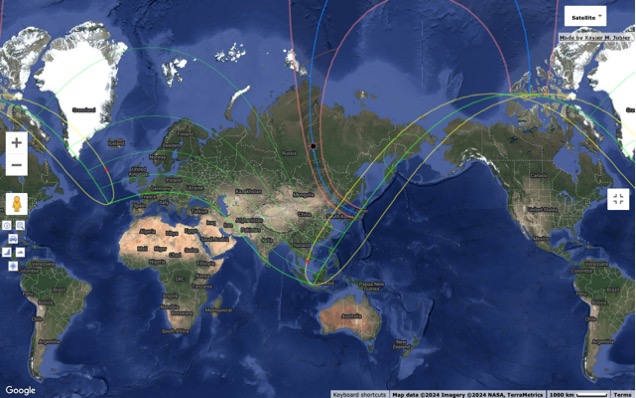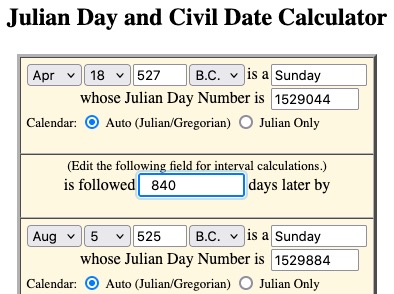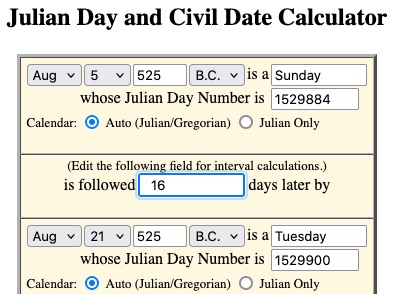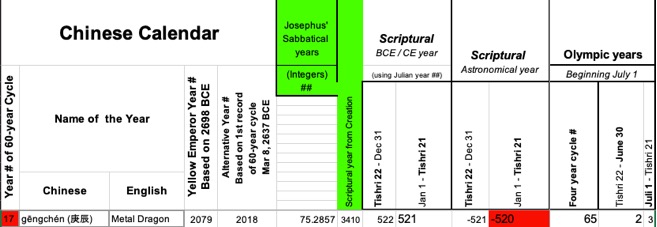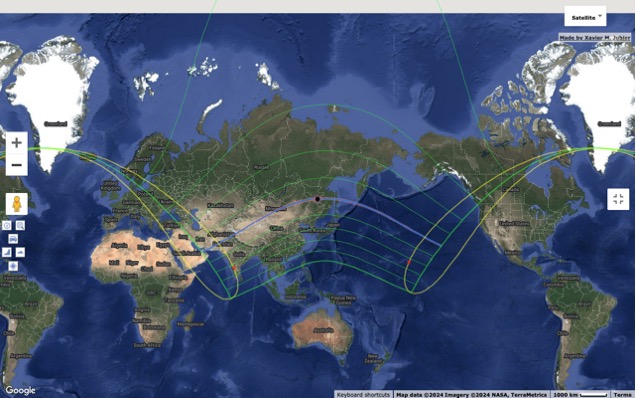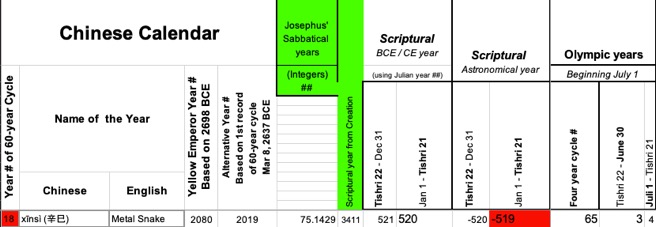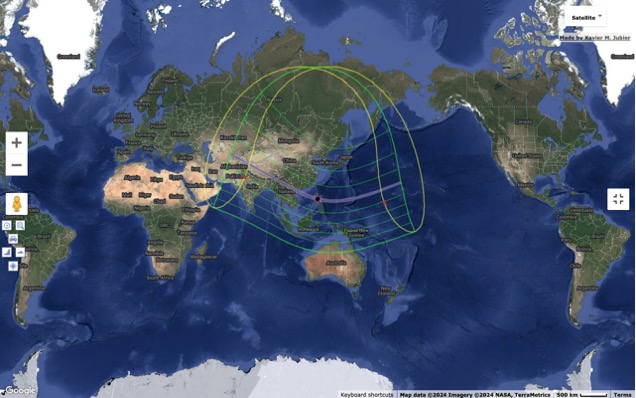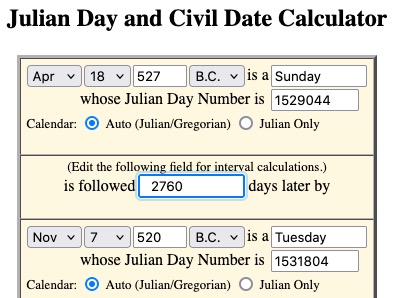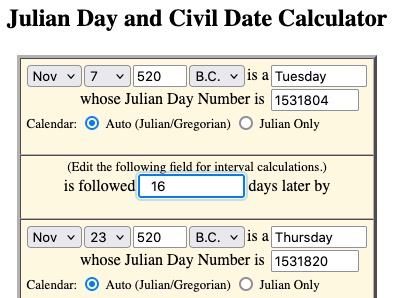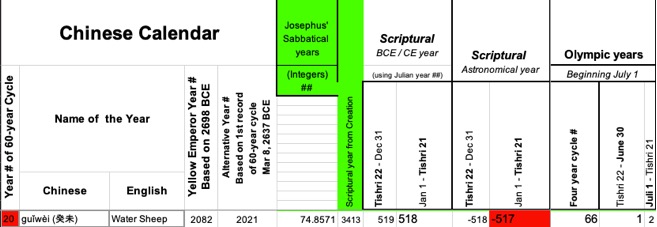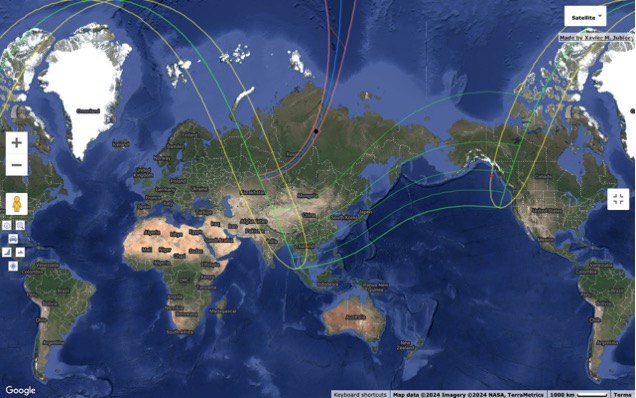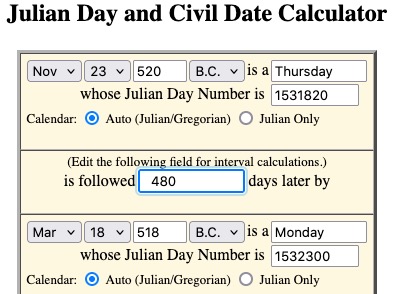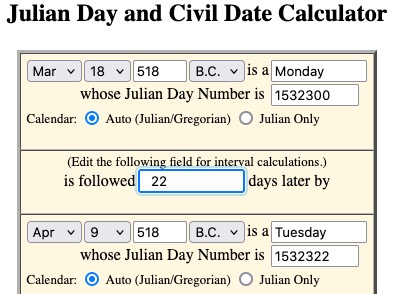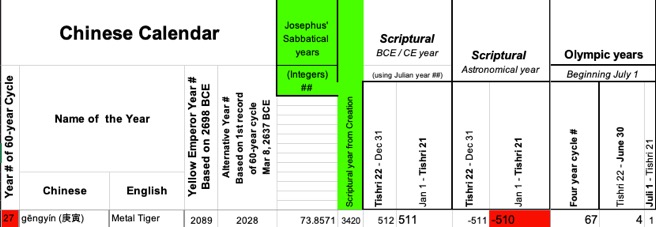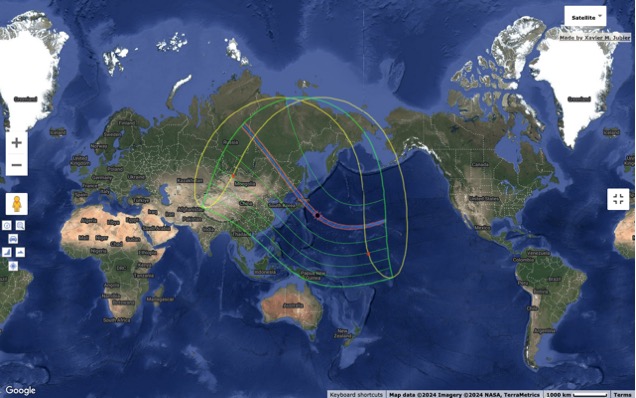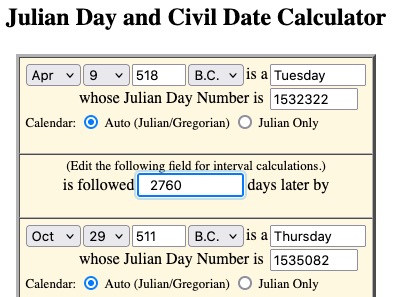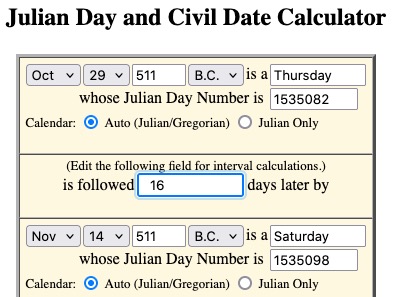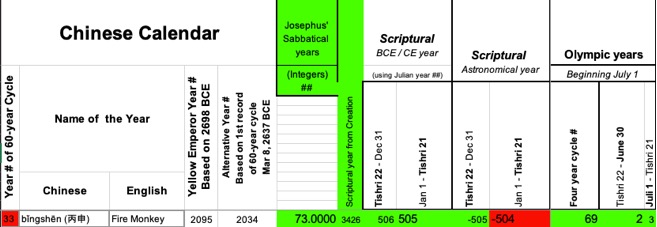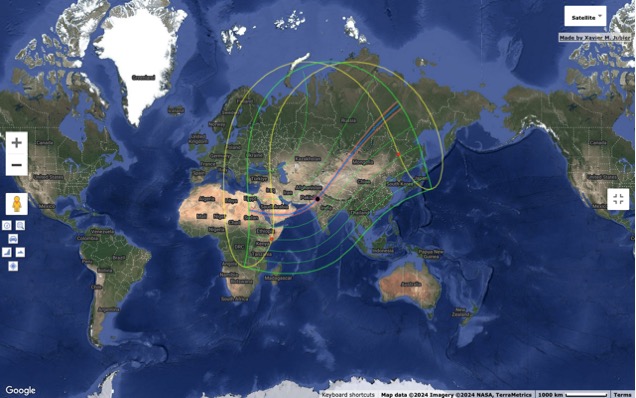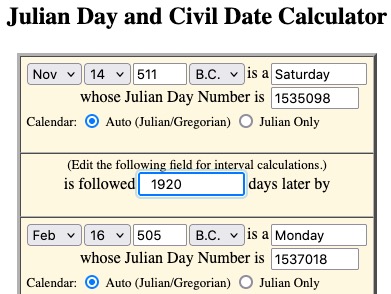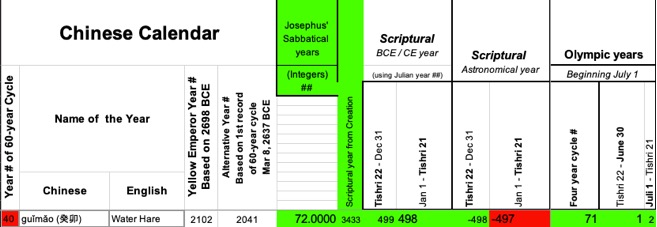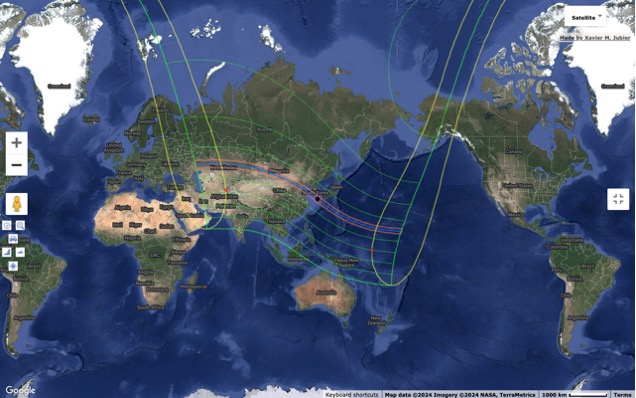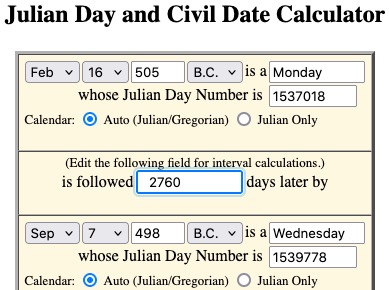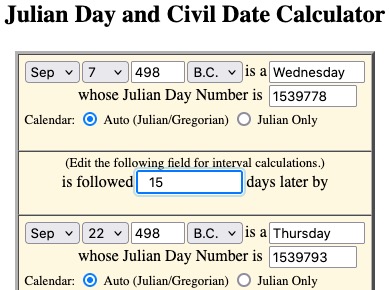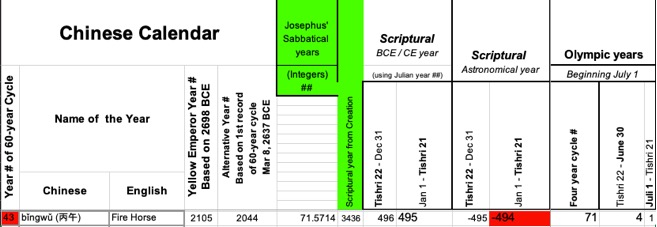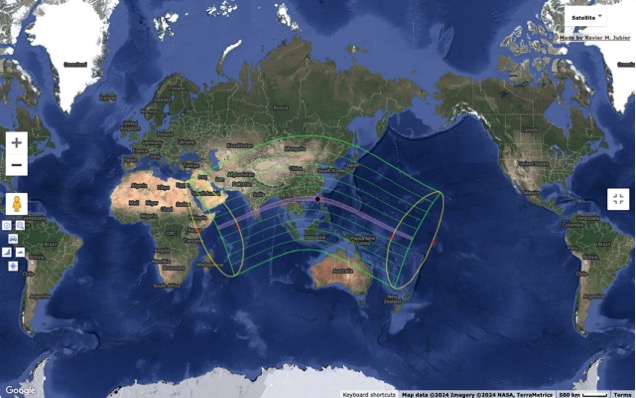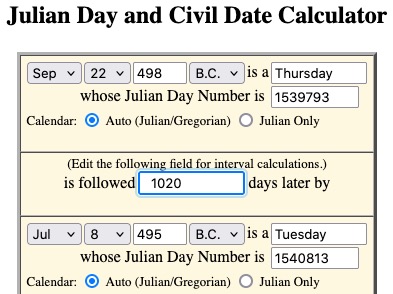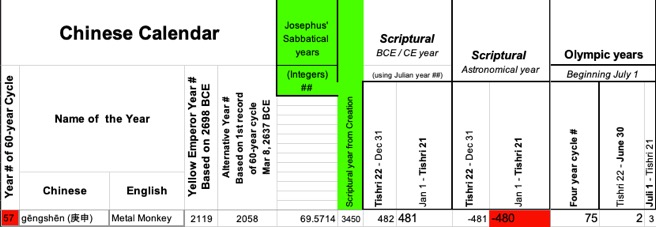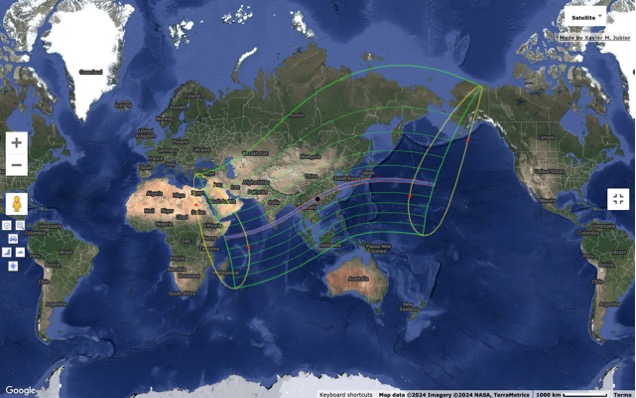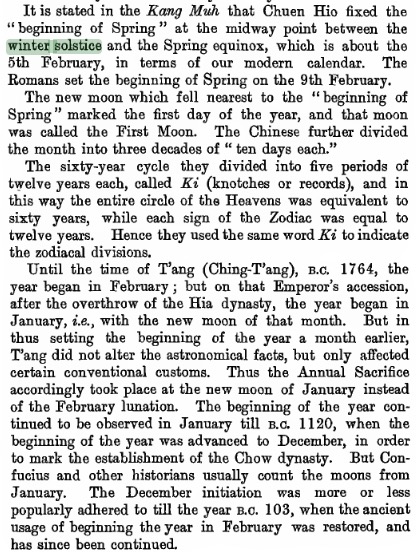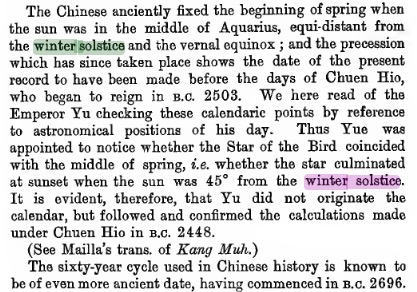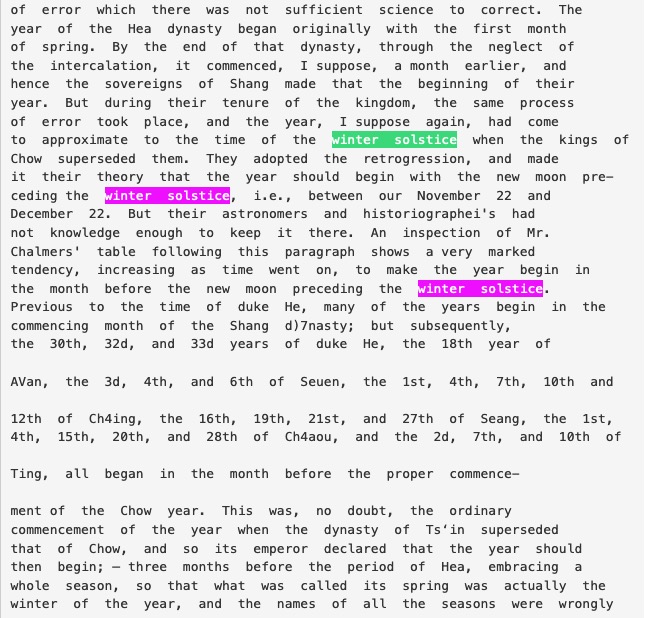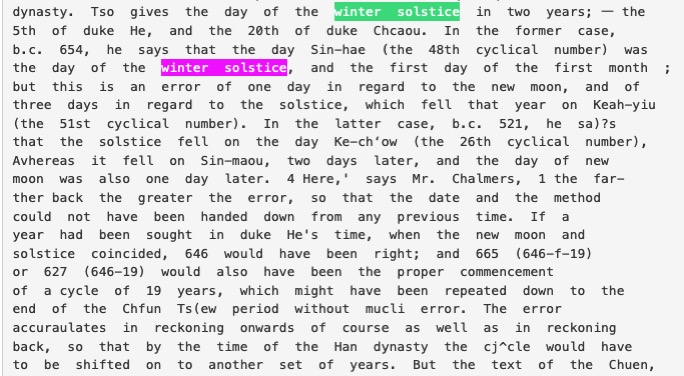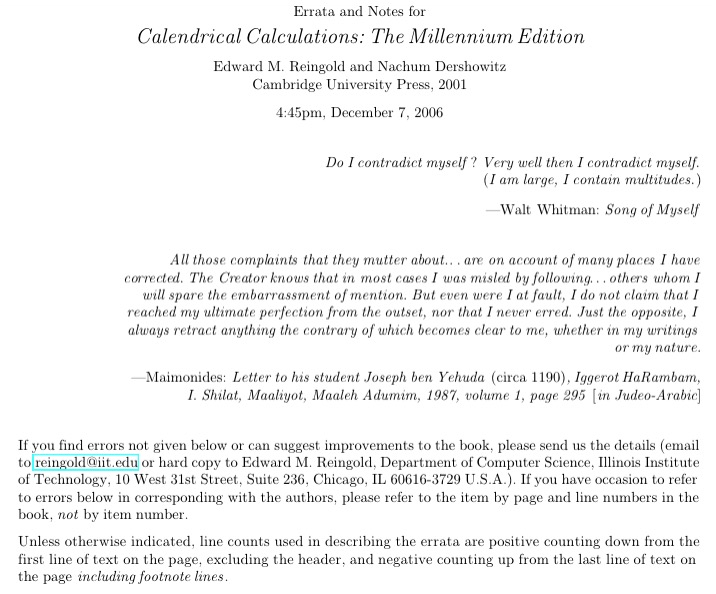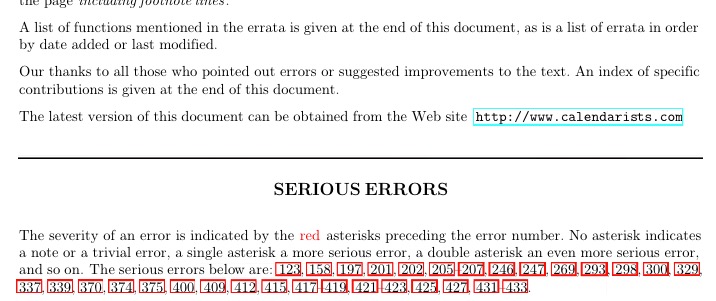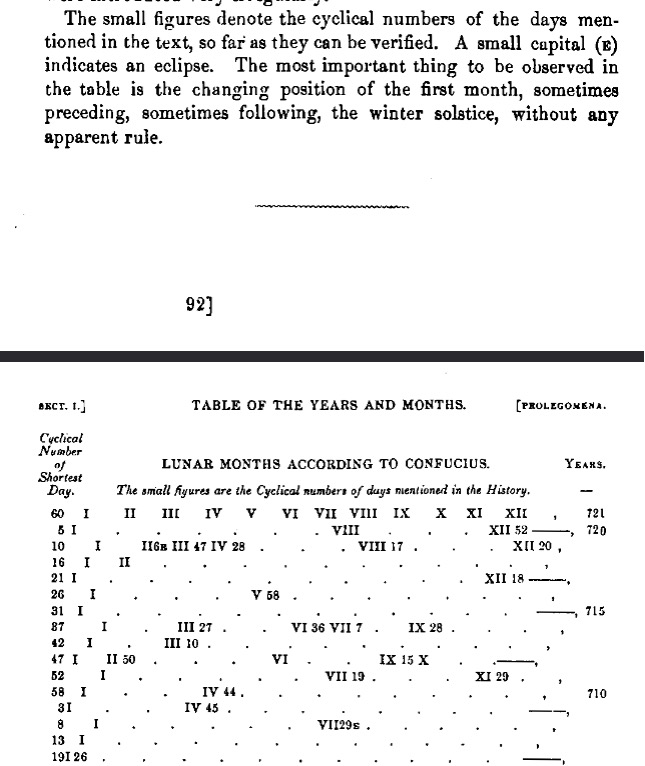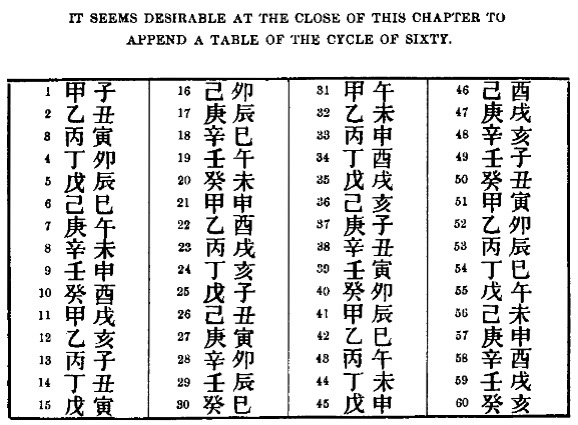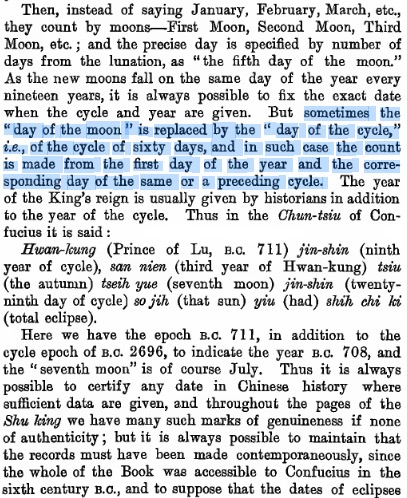Without recourse. All Rights Reserved. Tree of Life©
Statement of belief: “Sanctify
them through thy truth: thy word is truth.”
(John 17:17 KJV)
Cross Correlating the
Recorded
History
of
Ancient History, including the OT&NT Era vs.
Exactly
Dated Astronomical Events
-
Part
2 of 3
|
# |
What: |
When: |
References and Quotes: |
|
45 |
Solar eclipse prediction |
July
29, 588 BCE |
Notice: This solar eclipse is one of two very important
anchor points for the Olympic calendar and its use in ancient times. The second
one is the November 24, 29 CE total
solar eclipse. (A third one, August 15, 310 BCE, is being claimed by some as
an anchor point for the ancient Olympiad calendar, but this one was not
specifically dated by the original source in terms of Olympiad years and cannot
be relied upon as a certain anchor point in time. Please cf. my article at this link
for further details!) Notice: This total solar eclipse is, more than likely, the
one being referenced by Pliny as having occurred in the 4th year of the 48th
Olympiad, which year began July 1, 588 BCE. This July 29, 588 BCE annular
solar eclipse was visible from northern Greece: Cf. Fred Espenak’s map of solar eclipses from 600 BCE –
581 BCE, his map of this eclipse, and his interactive map of this eclipse! It follows also that, if Pliny as quoted is
correct, then AUC 1 began in 758 BCE! Quoting MrEclipse.com: "The original discovery (of the cause of eclipses) was made in
Greece by Thales of Miletus, who in the fourth year of the 48th
Olympiad (585/4 BC) foretold the eclipse of the Sun that occurred in the
reign of Alyattes, in the 170th year after the foundation of Rome (584/3 BC)" “Probably
refers to the total solar eclipse of 28 May 585 BC. Click here and here for Fred
Espenak's maps of the 585 BC eclipse. |
|
46 |
Numerous
celestial events observed and recorded upon the Babylonian clay tablet VAT
4956 |
April
22, 568 BCE – April 13 or 14, 567 BCE |
The Babylonian clay
tablet originally recorded in Nebuchadnezzar’s 37th and 38th year of reign. For
details and links to screen shots from my astronomy software re the
particulars of the observations upon the clay tablet, please cf. my analysis
and comments at this link. |
|
47 |
In
a Chinese record of 37 solar eclipses, the Annals of Lu aka. Ch’un Ts’ew,
Chun-tsiu, or Chun Chiu, of Confucius we find: Annular
solar eclipse visible in PM or at sunset as annular or partial eclipse in all
of China. |
Jan
14, 559 BCE annular solar eclipse. Visible in PM or at sunset as annular or
partial eclipse in all of China. |
“No. XVIII.” in the lists below:
“-558…January… 8…” “Year of Cycle… 39” “Moon… II” “Chinese Moon… II” “Visible
at Noon.”
Map showing the Jan 14, 559 BCE
annular solar eclipse visibility path. Visible in PM or at sunset as annular
or partial eclipse in all of China. Re “Day of Cycle… 32”: “Day of Cycle… 32” should mean the 32nd
day in a recurring cycle of exactly 60 days. Using this
basis: “An
alternative system is to start with the first historical record of the 60-day
cycle from March 8, 2637 B.C.E.” Unfortunately, I find no exact date
associated with “2698 B.C.E.”... But that hypothesis
failed when applied to the above listed 719 BCE and 720 BCE eclipses...
Reckoning instead from the last prior recorded Chinese solar eclipse (above
listed): I get the
result shown below. But that gives me 38, not “Day of Cycle… 32”. A
difference of +6 days (or -54 days)! Why? I don’t yet know!:
Conclusion: Apparently correctly identified
solar eclipse. |
|
48 |
In a Chinese record of 37 solar
eclipses, the Annals of Lu aka. Ch’un Ts’ew, Chun-tsiu, or Chun Chiu, of
Confucius we find: Partial solar eclipse. Scarcely visible at sunrise as
partial eclipse in north eastern China only. |
May 31, 558 BCE partial solar eclipse.
Scarcely visible at sunrise as partial eclipse in north eastern China only. |
“No. XIX.” in the lists below:
“-557…May… 23…” “Year of Cycle… 40” “Moon… VIII” “Chinese Moon… VI Intercal.” “Scarcely visible at
Sunrise”
Map showing the May 31, 558 BCE
partial solar eclipse visibility path. Scarcely visible at sunrise as partial
eclipse in north eastern China only. Re “Day of Cycle… 54”: “Day of Cycle… 54” should mean the 54th
day in a recurring cycle of exactly 60 days. Using this
basis: “An
alternative system is to start with the first historical record of the 60-day
cycle from March 8, 2637 B.C.E.” Unfortunately, I find no exact date
associated with “2698 B.C.E.”... But that hypothesis
failed when applied to the above listed 719 BCE and 720 BCE eclipses...
Reckoning instead from the last prior recorded Chinese solar eclipse (above
listed): I get the
result shown below. But that gives me 22, not “Day of Cycle… 54”. A
difference of -32 days (or +28 days)! Why? I don’t yet know!:
Conclusion: Apparently correctly identified
solar eclipse. |
|
49 |
A
pre-dawn lunar eclipse covering 83% of the lunar diameter. |
September
26, 554 BCE |
Quoting Nabonides’ Chronicle
(B.M. 35382; aka. Nabon. No. 24; aka. Stele H1, B:) “In the beginning of my everlasting reign they sent me a dream. Marduk, the great lord, and Sin, the luminary
of heaven and the netherworld, stood together. Marduk spoke with me: 'Nabonidus, king of Babylon…“ (Nabonides
Chronicle [i.8-ii.25] From GTR4, p. 116.) |
|
50 |
In
a Chinese record of 37 solar eclipses, the Annals of Lu aka. Ch’un Ts’ew,
Chun-tsiu, or Chun Chiu, of Confucius we find: An annular solar eclipse.
Visible around noon as annular or partial eclipse in the southern 2/3, of
China. |
Aug
31, 553 BCE annular solar eclipse. Visible in early PM as annular or partial
eclipse in the southern 2/3 of China. [After considering also XXI
and XXII in the list, the Aug
20, 552 BCE annular solar eclipse. Visible around noon as annular or partial
eclipse in all of China, does not apply to XX.] |
“No. XX.” in the lists below:
“-552…August… 25…” “Year of Cycle… 45” “Moon… X” “Chinese Moon… X” “Visible
at Noon”
Map showing the Aug 20, 552 BCE
annular solar eclipse visibility path. Visible around noon as annular or
partial eclipse in all of China. However, considering also XXI and XXII
below, it becomes more clear that the “calculated”
year number is intended as pointing to the astronomical year calendar, and
that this Aug 20, 552 BCE is the XXI eclipse… Map showing the Aug 31, 553 BCE
annular solar eclipse visibility path. Visible in early PM as annular or
partial eclipse in the southern 2/3 of China. Re “Day of Cycle… 53”: “Day of Cycle… 53” should mean the 53rd
day in a recurring cycle of exactly 60 days. Using this
basis: “An
alternative system is to start with the first historical record of the 60-day
cycle from March 8, 2637 B.C.E.” Unfortunately, I find no exact date
associated with “2698 B.C.E.”... But that hypothesis
failed when applied to the above listed 719 BCE and 720 BCE eclipses...
Reckoning instead from the last prior recorded Chinese solar eclipse (above
listed): I get the
results shown below. But that gives me 53 or 59…. Wow! Potential agreement
with “Day of Cycle… 53”! First potential agreement among twenty! Probably not
significant agreement. And indeed, after considering also XXI and XXII below,
the 53 result does not apply. Accordingly, I still don’t yet know!:
Conclusion: Apparently correctly identified
solar eclipse. |
|
51 |
|
|
BM3398 quote: Anchor point confirmation: Aug 6, 552 BCE 61% lunar eclipse. Accession
year of Nabonidus (cf. my file ScriptureChronology.xls). Confirmation also
that Nabonidus 17th year fell in 536/535 BCE!
Further confirmation of the significance and reality of this lunar
eclipse may be found in these words, as translated from the Harran Stele:
"At midnight, he (Sin) made me have a dream and said (in the dream) as
follows: “Rebuild speedily Ehulhul, the temple of Sin in Harran, and I will
hand over to you all the countries." That is, this lunar eclipse did in
fact take place "at midnight", 23:35 PM - 2:11 AM SN8 Mosul, Iraq
time. (Quote from: en.wikipedia.org/wiki/Harran_Stela). |
|
52 |
In
a Chinese record of 37 solar eclipses, the Annals of Lu aka. Ch’un Ts’ew,
Chun-tsiu, or Chun Chiu, of Confucius we find: Annular solar eclipse. Visible
around noon as annular or partial eclipse in all of China. |
Aug
20, 552 BCE annular solar eclipse. Visible around noon as annular or partial
eclipse in all of China. |
“No. XXI.” in the lists below:
“-551…August… 13…” “Year of Cycle… 46” “Moon… IX” “Chinese Moon… IX” “Visible
at Noon”
Map showing the Aug 9, 551 BCE
partial solar eclipse visibility path. Visible at sunset in north east China
only. Map showing the Aug 20, 552 BCE
annular solar eclipse visibility path. Within all of China, visible around
noon as partial or annular. Re “Day of Cycle… 47”: “Day of Cycle… 47” should mean the 47th
day in a recurring cycle of exactly 60 days. Using this
basis: “An
alternative system is to start with the first historical record of the 60-day
cycle from March 8, 2637 B.C.E.” Unfortunately, I find no exact date
associated with “2698 B.C.E.”... But that hypothesis
failed when applied to the above listed 719 BCE and 720 BCE eclipses...
Reckoning instead from the last prior recorded Chinese solar eclipse (above
listed): I get the
result shown below. But that gives me 54…. NOT “Day of Cycle… 47”! A difference of +7 days (or -53 days)! Why?
I don’t yet know!:
Conclusion: Apparently correctly identified
solar eclipse. |
|
53 |
An
evening total lunar eclipse beginning at 8:55 PM, local time in Babylon, and visible
until 12:33 AM. |
January
29, 551 BCE |
Quoting Nabonides’
Chronicle (B.M. 35382; aka. Nabon. No. 24; aka. Stele H1, B:) “At the beginning of the third
year [Nissan 551 BCE], they aroused him, Cyrus, the king
of Anšan, his second in rank.[2]
He scattered the vast Median hordes with his small army. He
captured Astyages, the king of the Medes, and took him to his country as
captive. Such was the word
[that is, the message provided by means of this eclipse shortly before the
beginning of Nabonides’ 3rd Babylonian year of reign / TLT © comment] of the great lord
Marduk [the Sun] and of Sin [the Moon,] the luminary of heaven and the
netherworld, whose command is not revoked.” (Nabonides
Chronicle [i.8-ii.25] From GTR4, p. 116.) |
|
54 |
In
a Chinese record of 37 solar eclipses, the Annals of Lu aka. Ch’un Ts’ew,
Chun-tsiu, or Chun Chiu, of Confucius we find: Partial solar eclipse. Visible
at sunset in north east China only. |
Aug
9, 551 BCE partial solar eclipse. Visible at sunset in north east China only. |
“No. XXII.” in the lists below:
“-551…September… [blank]…” “Year of Cycle… 46” “Moon… X” “Chinese Moon… X” “No
eclipse”
The solar eclipse that truly was:
Map showing the Aug 9, 551 BCE
partial solar eclipse visibility path. Visible at sunset in north east China
only. The “-551… September… No
Eclipse” Calculated non-event: The recorded eclipse as
listed in Dr Legge’s book:
No eclipse in “-551… September”. True…: And certainly not this very
visible solar eclipse (weather permitting, but China is large…): The solar eclipse closest in time
(11-41 days only) to the “-551 September” non-eclipse: Map showing the Aug
20, 552 BCE (-551) annular solar eclipse visibility path. Visible as annular
or partial around noon in all of China. Re “Day of Cycle… 17” and [blank]: Between “Day of Cycle… 47” (item XXI) associated
with the prior listed eclipse, and between “Day of Cycle… 17” (item XXII), in
a cycle of 60 days, there are [60-47=13] 13+17=30 days, suggesting that there
were exactly one, three, five, or etc. 30-day months between those two
eclipses. The Julian Day and Civil Date Calculator provides 354 Julian days
between the Julian Day calendar dates of said two eclipses (Aug 20, 552 BCE and Aug 9, 551 BCE.) That is, six (6) days off from an exact multiple of 30 days. Comparing that finding with items XXIV and
XXV, the second of only two instances (XXI:21/46 & XXII:21/46 AND
XXIV:24/49 & XXV:24/49) in the Chinese list with two eclipses within one
and the same year (Regnal Year as well as Year of Cycle), we have: Item XXIV:
“Day of Cycle… 1” and item XXV: “Day of Cycle… 30”. That is, one eclipse (Jun 20, 549 BCE)
is reckoned as occurring on “Day of Cycle… 1” and the other (Jun 9, 548 BCE)
is reckoned as occurring on “Day of Cycle… 30”, while yet being an exact
multiple, not of an exact 30 days, but, of exactly 12 lunar months, each of
which, by default, is reckoned as 30 days long. That is, using inclusive
reckoning, I find 13 astronomical new moons within 12 astronomical lunar
months. If each of those months are reckoned as 30 days [not as 29.5], then
we have 12x30=360, rather than the actual 12x29.5±=354±. Apparently, and albeit being shifted
relative to a seasonally adjusted calendar, each of said two instances in the
Chinese list comprise one and the same year (Including both “Year of Rule”
and “Year of Cycle”). That being the case, may shed some light
over the adjacent or subsequent
numbers for each of said two instances in the “Moon” column within the “AS RECORDED IN THE TEXT”
list? That is, the Moon numbers “IX… X” and “VII… VIII”. Noticing also that
X>IX and that VIII>VII, for the full lunar months of those “Moons” to
be included within one calendar year would require each of said two years to
include 14 full lunar months. That is, more than one intercalated month in
one calendar year, which I believe is more or less unheard of. However, if,
in each case, the second eclipsing “Moon” (i.e. X
and VIII respectably) is understood as the end point of such calendar year,
then, in each case we end up with 13 full months within each of said calendar
years. However, seeing also that, in each of said two eclipse pairs, the
beginning and ending eclipses are no more than 354 days, i.e.
12 lunar months, apart, I will have to conclude that, in each case, the “Year
of Cycle” and the “Year of Rule”, as recorded in the list, is defined as the
time period between the end of the first recorded lunar month (IX and VII
respectably), and between the very beginning of the last recorded lunar month
(X and VIII respectably). Strange reckoning, yes, but seemingly required by
the data available to us. That is, reviewing NASA’s
and xjubier’s list of solar eclipses for the years including -560 - -540
(561 BCE – 541 BCE), I find no instance of solar eclipses 29.5 days, only one
lunar month, apart while both solar eclipses also being visible within China.
Thus, said pairs of Moon numbers, “IX… X” and “VII… VIII” cannot possibly
constitute, for each year, two consecutive lunar months, while also confining
the placement of said years to within -560 - -540 (561 BCE – 541 BCE). So what about the number or lunar months, and about the “Day of Cycle” numbers
for the time period between said pairs of years (Aug 9, 551 BCE - Jun 20, 549 BCE)? Can we learn anything from this particular?:
660+21=681 days = 23 lunar months. 11x60=660 days.
From the Chinese list of eclipses…:
Reckoning cycles of 60 days while counting
all Julian days at face value, I get:
Reckoning each of said 23 lunar months as 30
days, I get: 23
x 30 days = 690 days More Hints re ”day of the cycle” reckoning below
this table…
Conclusion: Apparently correctly identified
solar eclipse. |
|
55 |
In a Chinese record of 37 solar eclipses, the Annals of Lu aka. Ch’un Ts’ew,
Chun-tsiu, or Chun Chiu, of Confucius we find: Annular solar eclipse. Visible
at sunrise in south west China only. Notice re this item in the Chinese
list of solar eclipses: An important once only[1]
typographical(?) error: “-550” rather than ‘-549’! A mix-up of the
Julian-Gregorian calendar vs the Astronomical calendar. |
[Jan 5, 550 BCE annular
solar eclipse. Visible at sunrise in most of China as annular or partial.] Dec 25, 550 BCE annular solar eclipse visibility path. Visible at sunrise
in south west China only. |
“No. XXIII.” in the lists below:
“-550…December… 30…” “Year of Cycle… 48” “Moon… II” “Chinese Moon… II” “Visible
at Sunrise”
Map showing the Jan 5, 550 BCE
annular solar eclipse visibility path. Visible at sunrise in most of China as
annular or partial. This eclipse is well within a year,
5 months, after the Aug 9, 551 BCE eclipse (XXII in the list), and is
therefore much too close to the year indicated as item #XXII in the “AS
RECORDED IN THE TEXT” list in Dr Legge’s book. Map showing the Dec 25, 550 BCE
annular solar eclipse visibility path. Visible at sunrise in south west China
only. This eclipse is 16 ½ months, after the Aug 9, 551 BCE eclipse, and
therefore a perfect match for item XXIII as subsequent to item XXII in the
“AS RECORDED IN THE TEXT” list in Dr Legge’s book. Re “Day of Cycle… 10”: “Day of Cycle… 10” should mean the 10th
day in a recurring cycle of exactly 60 days. Using this
basis: “An
alternative system is to start with the first historical record of the 60-day
cycle from March 8, 2637 B.C.E.” Unfortunately, I find no exact date
associated with “2698 B.C.E.”... But that hypothesis
failed when applied to the above listed 719 BCE and 720 BCE eclipses... Reckoning
instead from the last prior recorded Chinese solar eclipse (above listed): I get the result
shown below. But that gives me 23…. NOT “Day of Cycle… 10”, nor [blank]! A difference of +13 days (or -47 days)!
Why? I don’t yet know!:
Conclusion: Apparently correctly identified
solar eclipse. |
|
56 |
In a Chinese record of 37 solar
eclipses, the Annals of Lu aka. Ch’un Ts’ew, Chun-tsiu, or Chun Chiu, of
Confucius we find: A total solar eclipse. Within China: Visible at noon and
early PM in most of China as annular or partial. . |
Jun 20, 549 BCE Total solar
eclipse. Within China: Visible at noon and early PM in most of China as
annular or partial. |
“No. XXIV.” in the lists below:
“-548…June… 12…” “Year of Cycle… 49” “Moon… VII” “Chinese Moon… VII” “Total
about 1h. 15m. P.M.”
Map showing the Jun 20, 549 BCE
Total solar eclipse visibility path. Within China:
Visible at noon and early PM in most of China as annular or partial. Map showing the Jun 9, 548 BCE
total solar eclipse visibility path. Within China: Barely visible at sunrise
in the north east China corner only. However, this eclipse may be excluded
from this item #XXIV due to considerations discovered at items XX, XXI, and
XXII. Re “Day of Cycle… 1” and [blank]: “Day of Cycle…1” should mean the 1st day
in a recurring cycle of exactly 60 days. Using this
basis: “An
alternative system is to start with the first historical record of the 60-day
cycle from March 8, 2637 B.C.E.” Unfortunately, I find no exact date
associated with “2698 B.C.E.”... But that hypothesis
failed when applied to the above listed 719 BCE and 720 BCE eclipses...
Reckoning instead from the last prior recorded Chinese solar eclipse (above listed): I get the
result shown below. But that gives me 21…. NOT “Day of Cycle… 1”! A difference of +20 days (or -40 days)!
Why? I don’t yet know!:
Conclusion: Apparently correctly identified
solar eclipse. |
|
57 |
In a Chinese record of 37 solar eclipses,
the Annals of Lu aka. Ch’un Ts’ew, Chun-tsiu, or Chun Chiu, of Confucius we
find: A total solar eclipse. Within China: Barely visible as partial solar
eclipse at sunrise in the north east China corner only. . |
Jun 9, 548 BCE total solar eclipse. Within China: Barely visible at
sunrise in the north east China corner only. |
“No. XXV.” in the lists below:
“-548…July… [blank]…” “Year of Cycle… 49” “Moon… VIII” “Chinese Moon… VIII” “No
eclipse.”
Map showing the Jun 9, 548 BCE
total solar eclipse visibility path. Within China: Barely visible at sunrise
in the north east China corner only. Re “No eclipse”:
True, there was no solar eclipse in July -548, BUT, as seen
above, there truly was one on June 9, 548 BCE. So, which “No Eclipse” might most likely be intended by the
above “-548… July” entry in the Chinese list? Map showing the July 11, 551 BCE
partial solar eclipse visibility path. Within China: Not visible in China!
But certainly, there was an eclipse on July 11, 551 BCE. Likewise… Map showing the June 30, 550 BCE
total solar eclipse visibility path. Within China: Not visible in China! But certainly there was an eclipse on June 30, 550 BCE. And then this one… Map showing the June 19, 549 BCE
total solar eclipse visibility path. Within China: Visible as total or
partial at noon or in early PM all over China. Yes in “-548” (549 BCE), yet
not within the month July, that is some 11-42 days prior to “July” of that
year. How was this one missed? Re “Day of Cycle… 30” and [blank]: “Day of Cycle…30” should mean the 30th
day in a recurring cycle of exactly 60 days. Using this
basis: “An
alternative system is to start with the first historical record of the 60-day
cycle from March 8, 2637 B.C.E.” Unfortunately, I find no exact date
associated with “2698 B.C.E.”... But that hypothesis
failed when applied to the above listed 719 BCE and 720 BCE eclipses...
Reckoning instead from the last prior recorded Chinese solar eclipse (above
listed): I get the
result shown below. But that gives me 54…. NOT “Day of Cycle… 30”! A difference of +24 days (or -36 days)!
Why? I don’t yet know!:
Conclusion: Apparently correctly identified
solar eclipse. |
|
58 |
In a Chinese record of 37 solar eclipses, the Annals of Lu aka. Ch’un
Ts’ew, Chun-tsiu, or Chun Chiu, of Confucius we find: Total solar eclipse
visible as total or partial at sunrise in most of China.. |
Oct 13, 546 BCE total solar eclipse. Visibility within China: Visible
as total or partial at sunrise in most of China. |
“No. XXVI.” in the lists below:
“-545…October… 7…” “Year of Cycle… 52” “Moon… XII” “Chinese Moon… XI” “Visible
in the Morning”
Map showing the Oct 13, 546 BCE
total solar eclipse visibility path. Visibility within China: Visible as
total or partial at sunrise in most of China. Re “Day of Cycle… 12”: “Day of Cycle…12” should mean the 12th
day in a recurring cycle of exactly 60 days. Using this
basis: “An
alternative system is to start with the first historical record of the 60-day
cycle from March 8, 2637 B.C.E.” Unfortunately, I find no exact date
associated with “2698 B.C.E.”... But that hypothesis
failed when applied to the above listed 719 BCE and 720 BCE eclipses...
Reckoning instead from the last prior recorded Chinese solar eclipse (above
listed): I get the
result shown below. But that gives me 16…. NOT “Day of Cycle… 12”! A difference of +4 days (or -56 days)! Why?
I don’t yet know!:
Conclusion: Apparently correctly identified
solar eclipse. |
|
59 |
In a Chinese record of 37 solar eclipses, the Annals of Lu aka. Ch’un
Ts’ew, Chun-tsiu, or Chun Chiu, of Confucius we find: Total solar eclipse
visible as partial at noon and early PM in the SE 2/3 of China.. |
Mar 18, 535 BCE total solar
eclipse. Visibility within China: Visible as partial at noon and early PM in
the SE 2/3 of China. |
“No. XXVII.” in the lists below:
“-534…March… 11…” “Year of Cycle… 3” “Moon… IV” “Chinese Moon… IV” “Visible
in the Forenoon”
Map showing the Mar 18, 535 BCE
total solar eclipse visibility path. Visibility within China: Visible as
partial at noon and early PM in the SE 2/3 of China. Re “Day of Cycle… 41”: “Day of Cycle…41” should mean the 41st
day in a recurring cycle of exactly 60 days. Using this
basis: “An
alternative system is to start with the first historical record of the 60-day
cycle from March 8, 2637 B.C.E.” Unfortunately, I find no exact date associated
with “2698 B.C.E.”... But that hypothesis failed
when applied to the above listed 719 BCE and 720 BCE eclipses... Reckoning
instead from the last prior recorded Chinese solar eclipse (above listed): I get the
result shown below. But that gives me 29…. NOT “Day of Cycle… 41”! A difference of -12 days (or +48 days)!
Why? I don’t yet know!:
Conclusion: Apparently correctly identified
solar eclipse. |
|
60 |
In a Chinese record of 37 solar eclipses, the Annals of Lu aka. Ch’un
Ts’ew, Chun-tsiu, or Chun Chiu, of Confucius we find: Annular solar eclipse
visible as annular or partial around noon in all of China. |
Apr 18, 527 BCE annular solar
eclipse. Visibility within China: Visible as annular or partial around noon
in all of China. |
“No. XXVIII.” in the lists below:
“-526…Apr… 10…” “Year of Cycle… 11” “Moon… VI” “Chinese Moon… V” “Visible in
the Forenoon”
Map showing the Apr 18, 527 BCE
annular solar eclipse visibility path. Visibility within China: Visible as
annular or partial around noon in all of China. Re “Day of Cycle… 54”: “Day of Cycle…54” should mean the 54th day
in a recurring cycle of exactly 60 days. Using this
basis: “An
alternative system is to start with the first historical record of the 60-day
cycle from March 8, 2637 B.C.E.” Unfortunately, I find no exact date
associated with “2698 B.C.E.”... But that hypothesis
failed when applied to the above listed 719 BCE and 720 BCE eclipses...
Reckoning instead from the last prior recorded Chinese solar eclipse (above
listed): I get the result
shown below. But that gives me 13…. NOT “Day of Cycle… 54”! A difference of -41 days (or +19 days)!
Why? I don’t yet know!:
Conclusion: Apparently correctly identified
solar eclipse. |
|
61 |
In a Chinese record of 37 solar eclipses, the Annals of Lu aka. Ch’un
Ts’ew, Chun-tsiu, or Chun Chiu, of Confucius we find: Annular solar eclipse
visible as annular or partial in late PM in all of China. |
Aug 21, 525 BCE annular solar eclipse. Visibility within China:
Visible as annular or partial in late PM in all of China. |
“No. XXIX.” in the lists below:
“-524…Aug… 14…” “Year of Cycle… 13” “Moon… VI” “Chinese Moon… IX” “Visible in
the Afternoon”
Map showing the Aug 21, 525 BCE
annular solar eclipse visibility path. Visibility within China: Visible as
annular or partial in late PM in all of China. Re “Day of Cycle… 11… 10”: “Day of Cycle…11” should mean the 11th
day in a recurring cycle of exactly 60 days. Using this
basis: “An
alternative system is to start with the first historical record of the 60-day
cycle from March 8, 2637 B.C.E.” Unfortunately, I find no exact date
associated with “2698 B.C.E.”... But that hypothesis
failed when applied to the above listed 719 BCE and 720 BCE eclipses...
Reckoning instead from the last prior recorded Chinese solar eclipse (above
listed): I get the
result shown below. But that gives me 16…. NOT “Day of Cycle… 11”! A difference of +5 days (or -45 days)! Why?
I don’t yet know!:
Conclusion: Apparently correctly identified
solar eclipse. |
|
62 |
In a Chinese record of 37 solar eclipses, the Annals of Lu aka. Ch’un Ts’ew,
Chun-tsiu, or Chun Chiu, of Confucius we find: Total solar eclipse visible as
total or partial in late AM or around noon in all of China. |
Jun 10, 521 BCE total solar eclipse. Visibility within China: Visible
as total or partial in late AM or around noon in all of China. |
“No. XXX.” in the lists below:
“-521…June… 3…” “Year of Cycle… 17” “Moon… VII” “Chinese Moon… VII” “Visible
in the Forenoon”
Map showing the Jun 10, 521 BCE
total solar eclipse visibility path. Visibility within China: Visible as
total or partial in late AM or around noon in all of China. Re “Day of Cycle… 19”: “Day of Cycle…19” should mean the 19th
day in a recurring cycle of exactly 60 days. Using this
basis: “An
alternative system is to start with the first historical record of the 60-day
cycle from March 8, 2637 B.C.E.” Unfortunately, I find no exact date
associated with “2698 B.C.E.”... But that hypothesis
failed when applied to the above listed 719 BCE and 720 BCE eclipses...
Reckoning instead from the last prior recorded Chinese solar eclipse (above
listed): I get the
result shown below. But that gives me 13…. NOT “Day of Cycle… 19”! A difference of -41 days (or +19 days)!
Why? I don’t yet know!:
Conclusion: Apparently correctly identified
solar eclipse. |
|
63 |
In a Chinese record of 37 solar eclipses, the Annals of Lu aka. Ch’un
Ts’ew, Chun-tsiu, or Chun Chiu, of Confucius we find: Total solar eclipse
visible as total or partial in AM in all of China. |
Nov 23, 520 BCE total solar eclipse. Visibility within China: Visible
as total or partial in AM in all of China. |
“No. XXXI.” in the lists below:
“-519…November… 18…” “Year of Cycle… 18” “Moon… XII” “Chinese Moon… XII”
“Visible in the Afternoon”
Map showing the Nov 23, 520 BCE
total solar eclipse visibility path. Visibility within China: Visible as
total or partial in AM in all of China. Re “Day of Cycle… 10”: “Day of Cycle…10” should mean the 10th
day in a recurring cycle of exactly 60 days. Using this
basis: “An
alternative system is to start with the first historical record of the 60-day
cycle from March 8, 2637 B.C.E.” Unfortunately, I find no exact date
associated with “2698 B.C.E.”... But that hypothesis
failed when applied to the above listed 719 BCE and 720 BCE eclipses...
Reckoning instead from the last prior recorded Chinese solar eclipse (above
listed): I get the
result shown below. But that gives me 16…. NOT “Day of Cycle… 10”! A difference of +6 days (or -54 days)! Why?
I don’t yet know!:
Conclusion: Apparently correctly identified
solar eclipse. |
|
64 |
In a Chinese record of 37 solar eclipses, the Annals of Lu aka. Ch’un
Ts’ew, Chun-tsiu, or Chun Chiu, of Confucius we find: Annular solar eclipse
visible as annular or partial at sunrise or in early AM in all of China. |
Apr 9, 518 BCE annular solar eclipse. Visibility within China: Visible
as annular or partial at sunrise or in early AM in all of China. |
“No. XXXII.” in the lists below:
“-517…April… 1…” “Year of Cycle… 20” “Moon… V” “Chinese Moon… V” “Visible in
the Sunrise”
Map showing the Apr 9, 518 BCE
annular solar eclipse visibility path. Visibility within China: Visible as
annular or partial at sunrise or in early AM in all of China. Re “Day of Cycle… 32”: “Day of Cycle…32” should mean the 32nd
day in a recurring cycle of exactly 60 days. Using this
basis: “An
alternative system is to start with the first historical record of the 60-day
cycle from March 8, 2637 B.C.E.” Unfortunately, I find no exact date
associated with “2698 B.C.E.”... But that hypothesis
failed when applied to the above listed 719 BCE and 720 BCE eclipses...
Reckoning instead from the last prior recorded Chinese solar eclipse (above
listed): I get the
result shown below. But that gives me 22…. NOT “Day of Cycle… 32”! A difference of -10 days (or +50 days)!
Why? I don’t yet know!:
Conclusion: Apparently correctly identified
solar eclipse. |
|
65 |
In a Chinese record of 37 solar
eclipses, the Annals of Lu aka. Ch’un Ts’ew, Chun-tsiu, or Chun Chiu, of
Confucius we find: Total solar eclipse visible as total or partial at sunrise
or in early AM in almost all of China. |
Nov 14, 511 BCE total solar
eclipse. Visibility within China: Visible as total or partial at sunrise or
in early AM in almost all of China. |
“No. XXXIII.” in the lists below:
“-510…November… 7…” “Year of Cycle… 27” “Moon… XII” “Chinese Moon… XII”
“Visible in the Forenoon”
Map showing the Nov 14, 511 BCE
total solar eclipse visibility path. Visibility within China: Visible as
total or partial at sunrise or in early AM in almost all of China. Re “Day of Cycle… 48”: “Day of Cycle…48” should mean the 48th
day in a recurring cycle of exactly 60 days. Using this
basis: “An
alternative system is to start with the first historical record of the 60-day
cycle from March 8, 2637 B.C.E.” Unfortunately, I find no exact date
associated with “2698 B.C.E.”... But that hypothesis
failed when applied to the above listed 719 BCE and 720 BCE eclipses...
Reckoning instead from the last prior recorded Chinese solar eclipse (above
listed): I get the
result shown below. But that gives me 16…. NOT “Day of Cycle… 48”! A difference of -32 days (or +28 days)!
Why? I don’t yet know!:
Conclusion: Apparently correctly identified
solar eclipse. |
|
66 |
In a Chinese record of 37 solar
eclipses, the Annals of Lu aka. Ch’un Ts’ew, Chun-tsiu, or Chun Chiu, of Confucius
we find: Annular solar eclipse visible as annular or partial in PM or at
sunset in all of China. |
Feb 16, 505 BCE annular solar
eclipse. Visibility within China: Visible as annular or partial in PM or at
sunset in all of China. |
“No. XXXIV.” in the lists below:
“-504…February… 10…” “Year of Cycle… 33” “Moon… III” “Chinese Moon… III”
“Visible in the Noon”
Map showing the Feb 16, 505 BCE
annular solar eclipse visibility path. Visibility within China: Visible as
annular or partial in PM or at sunset in all of China. Re “Day of Cycle… 48”: “Day of Cycle…48” should mean the 48th
day in a recurring cycle of exactly 60 days. Using this
basis: “An
alternative system is to start with the first historical record of the 60-day
cycle from March 8, 2637 B.C.E.” Unfortunately, I find no exact date
associated with “2698 B.C.E.”... But that hypothesis
failed when applied to the above listed 719 BCE and 720 BCE eclipses...
Reckoning instead from the last prior recorded Chinese solar eclipse (above
listed): I get the result
shown below. But that gives me 60…. NOT “Day of Cycle… 48”! A difference of +12 days (or -48 days)!
Why? I don’t yet know!:
Conclusion: Apparently correctly identified
solar eclipse. |
|
67 |
In a Chinese record of 37 solar
eclipses, the Annals of Lu aka. Ch’un Ts’ew, Chun-tsiu, or Chun Chiu, of
Confucius we find: Annular solar eclipse visible as annular or partial in AM
in all of China. |
Sep 22, 498 BCE annular solar
eclipse. Visibility within China: Visible as annular or partial in AM in all
of China. |
“No. XXXV.” in the lists below: “-497…September…
15…” “Year of Cycle… 40” “Moon… XI” “Chinese Moon… X” “Visible in the
Forenoon”
Map showing the Sep 10, 497 BCE
partial solar eclipse visibility path. Visibility within China: Visible as
partial in late PM in most of China. However, this eclipse is not likely the one
intended by the author of the Chinese record… Map showing the Sep 22, 498 BCE
annular solar eclipse visibility path. Visibility within China: Visible as
annular or partial in AM in all of China. Re “Day of Cycle… 3”: “Day of Cycle…3” should mean the 3rd day
in a recurring cycle of exactly 60 days. Using this
basis: “An
alternative system is to start with the first historical record of the 60-day
cycle from March 8, 2637 B.C.E.” Unfortunately, I find no exact date
associated with “2698 B.C.E.”... But that hypothesis
failed when applied to the above listed 719 BCE and 720 BCE eclipses...
Reckoning instead from the last prior recorded Chinese solar eclipse (above
listed): I get the
result shown below. But that gives me 15…. NOT “Day of Cycle… 3”! A difference of +12 days (or -48 days)!
Why? I don’t yet know!:
Conclusion: Apparently correctly identified
solar eclipse. |
|
68 |
In a Chinese record of 37 solar eclipses,
the Annals of Lu aka. Ch’un Ts’ew, Chun-tsiu, or Chun Chiu, of Confucius we
find: Total solar eclipse visible as total or partial around noon in all of
China. |
Jul 22, 495 BCE total solar eclipse. Visibility within China: Visible
as total or partial around noon in all of China. |
“No. XXXVI.” in the lists below:
“-494…July… 15…” “Year of Cycle… 43” “Moon… VIII” “Chinese Moon… VIII”
“Visible in the Forenoon”
Map showing the Jul 22, 495 BCE
total solar eclipse visibility path. Visibility within China: Visible as
total or partial around noon in all of China. Re “Day of Cycle… 17”: “Day of Cycle…17” should mean the 17th
day in a recurring cycle of exactly 60 days. Using this
basis: “An
alternative system is to start with the first historical record of the 60-day
cycle from March 8, 2637 B.C.E.” Unfortunately, I find no exact date
associated with “2698 B.C.E.”... But that hypothesis
failed when applied to the above listed 719 BCE and 720 BCE eclipses...
Reckoning instead from the last prior recorded Chinese solar eclipse (above
listed): I get the
result shown below. But that gives me 14…. NOT “Day of Cycle… 17”! A difference of -3 days (or +57 days)! Why?
I don’t yet know!:
Conclusion: Apparently correctly identified
solar eclipse. |
|
69 |
In a Chinese record of 37 solar
eclipses, the Annals of Lu aka. Ch’un Ts’ew, Chun-tsiu, or Chun Chiu, of
Confucius we find: Total solar eclipse visible as total or partial around
noon in all of China. |
Apr 19, 481 BCE total solar
eclipse. Visibility within China: Visible as total or partial around noon in
all of China. |
“No. XXXVII.” in the lists below:
“-480…” “Year of Cycle… 57” “Moon… V”
Map showing the Apr 19, 481 BCE
total solar eclipse visibility path. Visibility within China: Visible as
total or partial around noon in all of China. Re “Day of Cycle… 17”: “Day of Cycle…17” should mean the 17th
day in a recurring cycle of exactly 60 days. Using this
basis: “An
alternative system is to start with the first historical record of the 60-day
cycle from March 8, 2637 B.C.E.” Unfortunately, I find no exact date
associated with “2698 B.C.E.”... But that hypothesis
failed when applied to the above listed 719 BCE and 720 BCE eclipses...
Reckoning instead from the last prior recorded Chinese solar eclipse (above
listed): I get the
result shown below. But that gives me 14…. NOT “Day of Cycle… 17”! A difference of -3 days (or +57 days)! Why?
I don’t yet know!:
Conclusion: Apparently correctly identified
solar eclipse. |
|
? |
A total lunar eclipse |
August 27, 413 BCE ? |
Notice: This eclipse
correlation is based solely upon the below reference and has no correlation,
that I am so far aware of, with my chronology. Accordingly, so far as I am
concerned, this may well be a flawed correlation! I am retaining the
reference for potential future use… Cf. Nicias’ eclipse below! Quoting a recent conventional authority: But on that very night, the moon, being full, was totally
eclipsed,b and not only Nicias himself, but all the Greeks with him,
were paralyzed with fear by what they considered a terrific portent. After
consulting a diviner, Nicias declared that the army could not embark until
the moon had completed another revolution. He was approaching his
destruction, and even nature seemed to conspire with ill fortune to ruin him.
In total inactivity he passed his time in sacrificing to the gods, while his
diviner consulted the auguries presented by the victims. His ships lay idly
at anchor, their seams opening under the blazing sun; his disheartened
soldiers made no attempt to prevent the Syracusans from hemming them in;
hundreds died of the malarial sickness spread by the pestilential swamp. b ) The eclipse dates the battle:
August 27, 413 B.C. (Crawford, Francis Marion, The Rulers of the South, Part 2 of
3, p. 143.) |
|
70 |
Total solar eclipse |
January 18, 402 BCE at 9:13± AM 2.
Saros map 3.
Total and Annular Solar Eclipse Paths 320-301 BCE 4.
Index to colored Saros maps of all solar eclipses
from 2000 BCE through 3000 CE |
Quoting
Thucydides re Pericles’ eclipse: “28. Also the same summer, on the first
day of the month according to the moon (at which time it seems only
possible), in the afternoon happened an eclipse of the sun. The which, after it had appeared
in the form of a crescent and withal some stars had been discerned, came afterwards again to the
former brightness.” History of the Peloponnesian War, Book II, Thucydides 2.47 Quoting Plutarch
re Pericles’ eclipse: “But when the ships were already manned, and Pericles
had gone aboard his own trireme, it chanced that the sun was eclipsed and darkness came on, and all were thoroughly
frightened, looking upon it as a great portent. 2 Accordingly,
seeing that his steersman was timorous and utterly perplexed, held up his
cloak before the man's eyes, and, thus covering them, asked him if he thought
it anything dreadful, or portentous of anything dreadful. "No,"
said the steersman. "How then," said Pericles, "is yonder
event different from this, except that it is something rather larger than my
cloak which has caused the obscurity?" At any rate, this tale is told in
the schools of philosophy.” Plutarch, The Parallel Lives, Vol III., The Life of Pericles Notice: For a detailed
analysis of this placement in time of the above quoted events re Pericles’
eclipse in the latter part of the 1st year of the Peloponnesian
War, that is, vs. the common placement some thirty years prior, please cf. my
article at this link! For as brief and
to the point analysis of the fundamental error behind conventional dating,
please follow this
link! |
|
71 |
Total lunar eclipse |
August 18, 385 BCE from moonrise at sunset until
9:11 PM local Syracuse time. |
Quoting Plutarch
re Nicias’ eclipse: “23 But just as everything was prepared
for this and none of the enemy were on the watch, since they did not expect
the move at all, there came an eclipse of the moon by night.” Plutarch,
Parallel Lives, The Life of Nicias, Vol
III:23 For details of
this identification, please follow this
link! For as brief and to
the point analysis of the fundamental error behind conventional dating,
please follow this
link! |
|
72 |
Hybrid solar eclipse |
Nov 5, 380 BCE observed at 8:00 AM local solar time
from Boeotia, Greece as a partial solar eclipse of 0.9 magnitude. |
Quoting Plutarch
re Agesilaüs’ eclipse: “17… 2 Agesilaüs now marched through the
pass of Thermopylae, traversed Phocis, which was friendly to Sparta, entered
Boeotia, and encamped near Chaeroneia. Here a partial eclipse of
the sun occurred, and at the same time news came to him of the death of
Peisander, who was defeated in a naval battle off Cnidus by Pharnabazus and
Conon..” Plutarch,
Parallel Lives, The Life of Agesilaüs, Vol
V:17 For details of this
identification, please follow this
link! For as brief and
to the point analysis of the fundamental error behind conventional dating,
please follow this
link! |
|
73 |
Annular solar eclipse |
Oct 6, 350 BCE at 8:25 AM local solar time visible
at Thebes as a partial solar eclipse of 0.928 magnitude.. |
Quoting Plutarch
re Pelopidas’ eclipse: “31. . . 2 The Thebans readily decreed what
they desired, and soon everything was in readiness and the commander about to set out, when the sun was eclipsed and the city was
covered with darkness in the day-time.[2]” Plutarch, Parallel Lives, The
Life of Pelopidas, 31:2 For details of
this identification, please follow this
link! For as brief and
to the point analysis of the fundamental error behind conventional dating,
please follow this
link! |
|
74 |
Total solar eclipse |
July 4, 336 BCE visible as a 85% partial eclipse
from Syracuse, Sicily. |
Quoting Plutarch re Helicon’s eclipse: “Helicon of Cyzicus, one of Plato's
intimates, predicted an eclipse of the sun. This took place as he had
predicted,
in consequence of which he was admired by the tyrant and presented with a
talent of silver.” Plutarch,
Parallel Lives, The
Life of Dion, 19:6 For details of
this identification, please follow this
link! For as brief and
to the point analysis of the fundamental error behind conventional dating,
please follow this
link! |
|
75 |
Total lunar eclipse |
September 20, 331 BCE Gaugamela,
Iraq horizon: moonrise: 17:52:33; sunset: 18:03:29; total eclipse from 20:36:32 until
21:47:13 Syracuse,
Italy horizon: partially eclipsed moonrise: 18:00:10;
sunset: 18:07:19; total eclipse from
18:52:00 until 19:58:00 |
Quoting Plutarch
re Alexander the Great’s eclipse: 6 Now, the great battle against Dareius was not fought at
Arbela, as most writers state, but at Gaugamela.59 7 The word signifies,
we are told, "camel's house," since one of the ancient kings of the
country, after escaping from his enemies on a swift camel, gave the animal a
home here, assigning certain villages and revenues for its maintenance.
8 It so happened that in the month Boëdromion the moon suffered an eclipse,[3]
about the beginning of the Mysteries at Athens, and on the eleventh night after
the eclipse, the armies being now in sight of one another, Dareius kept his
forces under arms, and held a review of them by torch-light; 9 but
Alexander, while his Macedonians slept, himself passed the night in front of
his tent with his seer Aristander, celebrating certain mysterious sacred
rites and sacrificing to the god Fear. (Plutarch, Parallel Lives, The
Life of Alexander, Vol 4:6) Quoting Plutarch
re Dion’s eclipse: 23…
4 It was not until later times that the radiant repute of Plato, because
of the life the man led, and because he subjected the compulsions of the
physical world to divine and more sovereign principles, took away the obloquy
of such doctrines as these, and gave their science free course among all men.
At any rate, his friend Dion, although the moon suffered an eclipse at the time when he was about to set
out from Zacynthus on his voyage against Dionysius, was in no wise disturbed, but put to sea, landed at
Syracuse, and drove out the tyrant.[4] (Plutarch, Parallel
Lives, The
Life of Nicias) 24
But after the libations and the customary prayers, the moon was
eclipsed.[5] 25:
6 Thereupon a boisterous wind from the north rushed down upon them,
raised a great sea, and drove the ships away from Sicily, while flashes of
lightning and peals of thunder, now that Arcturus was just rising,[6]
conspired to pour down from the heavens against storm of furious rain. (Plutarch, Parallel
Lives, The
Life of Dion) Quoting Plinivs
Secundus re both Alexander’s and Dion’s eclipse: “CHAP. LXX. “Of the unequall rising of the Starres: of the Eclipse, both
where and how it commeth. “...At what time as Alexander the
Great wan that famous victorie at Arbela, the moone (by report) was eclipsed
at the second houre of the night: but at the very same time in Sicilie, she
[came forth (out of the eclipse…) / ToL edit]” (C. Plinivs Secvndvs, The Second Booke of
the Historie of Natvre, Chapter LXX) “LXXII “Ideo defectus solis
ac lunae vespertinos orientis incolae non sentiunt nec matutinos ad occasum
habitantes, meridianos vero serius nobis illi. apud
Arbilam Magni Alexandri victoria luna defecisse noctis secunda hora est
prodita eademque in Sicilia exoriens.” (C. Plinivs Secvndvs, Liber II, Chapter LXXII) For details of
this identification, please follow this
link! For as brief and to
the point analysis of the fundamental error behind conventional dating,
please follow this
link! |
|
76 |
Total solar eclipse |
August 15, 310 BCE 2.
Saros map |
Quoting Diodorus
Sicilus re Agathocles’ eclipse of the sun: “5… 5 On the
next day there occurred such an eclipse of the sun that
utter darkness set in and the stars were seen everywhere;** wherefore
Agathocles' men, believing that the prodigy portended misfortune for them,
fell into even greater anxiety about the future…” Diodorus Sicilus,
Library of History, Book XX, with original
editor’s footnotes. There are two reliable anchor points for the ancient
Olympiad calendar: 1) July 29, 588 BCE, and 2) Nov 24, 29 CE. Notice: Although
this solar eclipse is no doubt the one experienced by Agathocles, it is being
incorrectly associated with “Ol. 117, 3” and can definitely not be relied upon
as a certain anchor point for the reckoning of Olympiad years! For details,
please cf. my article under this link! For as brief and to
the point analysis of the fundamental error behind conventional dating,
please follow this
link! |
|
77 |
Total lunar eclipse |
November 14, 222 BCE visible for less than ½ hour as
a partially eclipsed moon in west north west at sunset/moonrise. |
Quoting Polybius
re Attalus’ eclipse of the moon: 78 While he [Attalus] was
here, an eclipse of the moon took place,[7] and the Gauls,
who had all along been aggrieved by the hardships of the march — since they
made the campaign accompanied by their wives and children, who followed them
in wagons — 2 considering this a bad omen, refused to advance further.
3 King Attalus, to whom they rendered no service of vital importance, and
who noticed that they detached themselves from the column on the march and
encamped by themselves and were altogether most insubordinate and
self-assertive, found himself in no little perplexity. (Polybius, The Histories, Book
V) For details of
this identification, please follow this
link! For as brief and
to the point analysis of the fundamental error behind conventional dating,
please follow this
link! |
|
78 |
Total solar eclipse |
March 14, 190 BCE at 7 AM local solar time. |
Quoting Cassius
Dio re Hannibal’s eclipse of the sun: “Accordingly, the Romans entered the conflict well marshalled and eager, but Hannibal and the Carthaginians listless and dejected. This was owing in part to a total eclipse of the sun; for in view of the other circumstances, Hannibal suspected that this, too, augured nothing auspicious for them.” (Cassius Dio, Roman History, Vol. II:14,
p. 264) For details of
this identification, please follow this
link! For as brief and
to the point analysis of the fundamental error behind conventional dating,
please follow this
link! |
|
79 |
Partial lunar eclipse |
October 3, 145 BCE visible from the Baghdad
vicinity, beginning at sunset / moonrise at about 5:45 PM. Maximum magnitude
was 48.8% |
Quoting
A. T. Olmstead, Cuneiform
Texts and Hellenistic Chronology: “Mithradates I
conquered Seleucia before the
lunarc eclipse of year 171, Duzu 13
(July 22, 141 B.C.)…” (A. T. Olmstead, Cuneiform
Texts and Hellenistic Chronology, Classical Philology, Vol. 32, No. 1
(Jan. 1937,) pp 1-14.) For details of this
identification, please follow this
link! For as brief and
to the point analysis of the fundamental error behind conventional dating,
please follow this
link! |
|
80 |
Total lunar eclipse |
June 1, 139 BCE between 8 PM and 1 AM |
Quoting Plutarch: “7 Now, when night had come, and the
soldiers, after supper, were betaking themselves to rest and sleep, on a
sudden the moon, which was full and high in the heavens, grew dark, lost its
light, took on all sorts of colours in succession, and finally disappeared. 8 The Romans, according to their
custom, tried to call her light
back by the clashing of bronze utensils and by holding up many blazing
fire-brands and torches towards the heavens; the Macedonians, however, did nothing of this sort, but
amazement and terror possessed their camp, and a rumour quietly spread among
many of them that the portent signified an eclipse of a king. 9 Now,
Aemilius was not altogether without knowledge and experiences of the
irregularities of eclipses, which, at fixed periods, carry the moon in her course
into the shadow of the earth and conceal her from sight, until she passes beyond the region of
shadow and reflects again
the light of the sun; 10 however, since he was very devout and given to
sacrifices and divination, as soon as he saw the moon beginning to emerge from the shadow, he
sacrificed eleven heifers to
her…” Plutarch, The Life of
Aemilius 17.7 Quoting C. Plinivs Secvndvs: “The reason verily of both eclipses, the first
Romane that published abroad and divulged, was Sulpitius Gallus, who afterwards was Consul, together
with M. Marcellus: but at that time being a Colonell,
the day before that king Perseus was vanquished by Paulus, he was brought forth by the Generall into open audience
before the whole hoast, to fore-tell the eclipse which should happen the
next morrow: whereby he delivered the armie from all
pensivenesse and fear, which might have troubled them in the time of
battaile, and within a while after hee compiled also a booke thereof. But
among the Greekes, Thales Milosius was the first that found it out, who in
the 48 Olympias, and the fourth yeere thereof, did prognosticate and foreshew
the Sunnes eclipse that happened in the raigne of Halyattes, and in the 170
yeere after the foundation of the citie of Rome.” C. Plinivs Secvndvs, The Second Booke of
the Historie of Natvre, Chap. VII Notice: For a detailed analysis
of this placement in time of the above quoted events re the Battle at Pydna,
that is, vs. the common placement some thirty years prior, please cf. my
article at this link! For as brief and to the point analysis of the
fundamental error behind conventional dating, please follow this
link! |
|
81 |
A partial lunar eclipse (Maximum magnitude: 0.5098.) |
As seen from the Numantine horizon in Spain on May
1, 109 BCE: Moonrise at 18:37 with 24% umbral eclipse-19:04; penumbral
eclipse -20:26. Sunset was at 19:08 local solar time. |
Quotes re
Aemilius Lepidus’ lunar eclipse: “[§82] The siege of Pallantia was long protracted, the food supply of the Romans failed, and they began to suffer
from hunger. All their animals perished and many of the men died of want. The
generals, Aemilius and Brutus, kept heart for a long time. Being compelled to yield at last, they gave an order
suddenly one night, about the last watch, to retreat. The tribunes and
centurions ran hither and thither to hasten the movement, so as to get them
all away before daylight. Such was the confusion that they left behind
everything, and even the sick and wounded, who clung to them and besought
them not to abandon them. Their
retreat was disorderly and confused and much like a flight, the Pallantines
hanging on their flanks and rear and doing great damage from early dawn till
evening. When night came, the
Romans, worn with toil and hunger, threw themselves on the ground by
companies just as it happened, and the Pallantines, moved by some divine interposition,
went back to their own country. And
this was what happened to Aemilius.“ (Appian’s History of Rome) “Suffering from a lack of food, the Romans were compelled
to retreat and desperately tried to decamp under cover of darkness. "Such
was the confusion that they left behind everything, and even the sick and
wounded, who clung to them and besought them not to abandon them." Only a
lunar eclipse saved the Romans from being pursued. Lepidus was deprived of his command while still in the
field (the first time that such an abrogation ever had occurred) and recalled
to Rome in disgrace.” Notice: For a detailed analysis
of this placement in time of the above quoted events re the Aemilius Lepidus’
lunar eclipse, please cf. my article at this link! For as brief and to the point analysis of the
fundamental error behind conventional dating, please follow this
link! |
|
82 |
A comet |
49 BCE, April 14 – May 12 |
Pliny quoting Augustus: “ ‘On the very days of my Games a comet
was visible for seven days in the northern part of the sky. It was [in “the
eleventh hour of the day”], and was a bright star visible from all lands.’ ” (Pliny, Natural History, 2.23.) Quoting Ronald L. Conte Jr.: “This
comet is often depicted in ancient images of Julius Caesar. “In
49 B.C., Chinese astronomers recorded seeing a comet during the lunar month
of April 14 to May 12 in the constellation Cassiopeia.819 This
constellation, as seen from Rome during that time period, was in the northern
part of the sky. The comet of 49 B.C. would also have been seen in the
northern part of the sky, matching the words of Augustus closely. Also, the
time of year is… correct for the comet following the death of Julius Caesar,
who died in mid March. “The
comet associated with the death of Julius Caesar was seen either an hour
before, or a little after, sunset. This time frame for the visibility of the
comet fits the 49 B.C. comet. During this time period (April 14 to May 12), the
constellation Cassiopeia was above the horizon and clearly visible from Rome
before, during, and after sunset.820 At about the time of sunset,
Cassiopeia was almost exactly due north, as viewed from Rome. Thus the comet
of 49 B.C. would have been clearly visible in the north, as the sky first began
to dim, a little after sunset. “Based
on the above information, the comet of 49 B.C. is the only fit for the
information given by Pliny and Augustus for the comet following the death of
Julius Caesar. This comet was located in the northern part of the sky, was
visible about the eleventh hour of the day, and could well have been rising
at that time of day. “The
above information on both comets and solar eclipses points to the same
conclusion… Julius Caesar died in mid March of 49 B.C...” 810 Pliny, Natural History, 2.23. The same comet is also mentioned by numerous other ancient
writers. See Kronk, Cometography, p. 22, for a listing. 819 Kronk, Cometography, p. 21. 820 RedShift 3 astronomy
software. Cometary
data are from Gary W. Kronk, Cometography, A Catalog of Comets, (Cambridge, United Kingdom: Cambridge University Press, 1999) |
|
83 |
Solar eclipse |
49 BCE, August 9, at 10:17 UT |
Pliny: “Portentous and protracted eclipses of the
sun occur, such as the one after the murder of Caesar the dictator….” Pliny, Natural History, 2.30. Julius Caesar
is obviously the one referred to as the dictator who was murdered. The
circumstances of his death, described by Suetonius, Josephus, and others make
it clear Julius Caesar was murdered. And he was long thought of, and referred
to, in ancient Rome, as a dictator. |
|
84 |
A comet |
32 BCE, in
the lunar month beginning on February 6 |
Dio: “…and for many days a flaming torch was seen
to rise over the sea in the direction of Greece, and to soar aloft in the
sky.” Dio, The Roman History,
Penguin Books, p. 40. See also: Dio, Roman History, Volume V, Loeb
Classical Library, 50.8.2. |
Hints re ”day of the cycle” reckoning:
Notice
“till B.C. 1120, when the beginning of the year was advanced to December… But
Confucius… count the moons from January… adhered to till the year B.C. 103…”
Notice:
“Chow… the year should begin with the new moon preceding the winter solstice…
the year begin in the month before the new moon preceding the winter solstice.”
Notice: “Tso gives the day of the winter solstice in two years; 一 the 5th of duke He, and the 20th of duke Chcaou. In the former case, b.c. 654, he says that the day Sin-hae (the 48th cyclical number) was the day of the winter solstice, and the first day of the first month ; but this is an error of one day in regard to the new moon, and of three days in regard to the solstice, which fell that year on Keah-yiu (the 51st cyclical number). In the latter case, b.c. 521, he sa)?s that the solstice fell on the day Ke-ch‘ow (the 26th cyclical number), Avhereas it fell on Sin-maou, two days later, and the day of new moon was also one day later.!”
SN8 provides at Near Mulan, China on Dec 5, 654 BCE astronomical New Moon at 02:30, visible New Moon on Dec 6, and winter solstice Dec 28, 654 BCE at 09:30. Thus 22 days between those two events, not only 3±1 days “error” as above suggested. Big difference! Looks like there may be many errors between the source and our current understanding of this issue…
Quote from page 304 in The Shu King:
“Day of Cycle… 17” should mean the 17th day in a recurring
cycle of exactly 60 days. Using this
basis:
“An
alternative system is to start with the first historical record of the 60-day
cycle from March 8, 2637 B.C.E.” Unfortunately, I find no exact date
associated with “2698 B.C.E.”... But that hypothesis
failed when applied to the above listed 719 BCE and 720 BCE eclipses...
Reckoning instead from the last prior recorded Chinese solar eclipse (above
listed):
I get the result shown below. But
that gives me 54…. NOT “Day of Cycle… 17”, nor [blank]! A difference of +37 days (or -23 days)! Why?
I don’t yet know!
But notice the similarity between the Chinese characters ![]() and
and ![]() above:
above:
Comments and donations freely
accepted at:
eMail: TreeOfLifeTime@gmail.com
You are
hereby cordially invited to subscribe to our free email course:
You’ll discover firsthand the fundamentals for understanding Scripture time
reckoning as used by the ancient historian Josephus as well as by all the
authors of the Holy Scriptures! Much of this knowledge has - until now - been
lost to the best of scholars for many centuries.
“Great truths which have been neglected and
unappreciated for ages will be revealed by the Spirit of God, and new meaning
will flash out of familiar texts. Every page will be illuminated by the Spirit
of truth. The Bible is not sealed but unsealed. The most precious truths are
revealed; the living oracles are heard by wondering ears, and the consciences
of men are aroused into action.”
You will make many surprising and exciting discoveries re the exact
dates for Jesus’ birth, crucifixion, resurrection, ascension… as well as the
exact dates of many, many more events found in your Bible, especially re the
New Testament times.
You’ll discover the exact dates for the 12+ Roman Caesars beginning with
Julius Caesar, Augustus, Tiberius, Gaius, Claudius, Nero, Vespasian, Titus…
You’ll discover the exact dates of most of the kings of Judah beginning
with Hyrcanus in the 2nd century BCE, Herod the Great, Agrippa, and
many other Judean kings and proconsuls, e.g. Pontius
Pilate…
You’ll discover many things re the Scripture traditions honored by all
the disciples and believers of the Apostolic times – as well as by the Jews –
traditions that have been long forgotten or not correctly restored when
previously re-discovered…
Be prepared to re-think and to re-learn… Things may not be as you always
thought they were… But you’ll decide!
“Get
Your Tree of Life © 1st Century Chronology & Scripture Calendar
Introductory Course NOW…”:
It is a very simple Basics 101 type course entitled:
Tour
Guide towards “Tuning into the Frequency of the Creator & Becoming Oriented
in His Time…”
It is
one short email per week for you to enjoy with your family and friends…
The GateWays into Tree of
Life Chronology Forums©
Without recourse. All Rights Reserved. Tree of Life©

